
The Project Gutenberg EBook of Kodaks and Kodak Supplies, 1914, by Canadian Kodak Company This eBook is for the use of anyone anywhere at no cost and with almost no restrictions whatsoever. You may copy it, give it away or re-use it under the terms of the Project Gutenberg License included with this eBook or online at www.gutenberg.org Title: Kodaks and Kodak Supplies, 1914 Author: Canadian Kodak Company Release Date: July 16, 2010 [EBook #33183] Language: English Character set encoding: ISO-8859-1 *** START OF THIS PROJECT GUTENBERG EBOOK KODAKS AND KODAK SUPPLIES, 1914 *** Produced by V. L. Simpson and the Online Distributed Proofreading Team at http://www.pgdp.net (This file was produced from images generously made available by The Internet Archive/Canadian Libraries.)



Canadian Kodak Co., Limited
Toronto, Canada
Is our registered and commonlaw trade mark and cannot be rightfully applied except to goods of our manufacture. When a dealer tries to sell you, under the Kodak name, a camera or films or other goods not of our manufacture, you can be sure that he has an inferior article that he is trying to market on the Kodak reputation, and he also makes himself liable to suit by us for damages and injunction.

If it isn't an Eastman, it isn't a Kodak

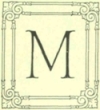 ake it simpler.
ake it simpler.
From the very inception the Kodak Idea has been—make photography so simple that anybody can take good pictures.
Simpler cameras, simpler processes have followed each other with almost startling rapidity. But the Kodak Company has not been satisfied with merely making mechanical and chemical improvements; it has assumed the responsibility of educating people in picture taking. The very first Kodak, way back in 1888, was accompanied by a so-called "manual" that did more than merely explain the operation of the mechanical features of the camera. It showed how the pictures should be taken, how (and how not) to photograph a tall building, how to photograph a small child—told about the length of exposures in different kinds of light, both in-doors and out. It was really a primary hand-book of photography.
From that day on, every piece of Kodak apparatus, every amateur product of the Company has been accompanied by the most concise instructions, instructions that were also constructive because they not only told the beginner what to do but why he was to do it. Even in the Kodak [Pg 4]advertising matter as much space is given up to telling people how to make pictures as in telling them why they should buy Kodak goods. Booklets in large editions, giving instructions in practically every phase of amateur photography have been and still are distributed without charge. Photography has not merely been made simpler, it has been explained to all who are interested.
And now comes a new help to the beginner—"Kodakery," a little magazine that will tell the amateur how to get better pictures. It's beautifully illustrated. Written and edited by those who know photography inside and out and who also know the places where the amateur has trouble, it will be a joy and a help to every enthusiast, will add for thousands to the Witchery of Kodakery.
Every purchaser, after May 1st, 1914, of a Kodak or Brownie camera will be entitled to "Kodakery" for one year without charge—he may have it continued by subscribing at 50 cents per year if he so desires. In the back of each Kodak and Brownie manual, which we are now printing, is a "subscription blank" which, upon being properly filled out and mailed to—"Kodakery," Toronto, Ont.—will entitle the purchaser of such camera to one year's free subscription to "Kodakery." At the time this plan goes into operation there may still be some such manuals without a subscription blank, but in such case a blank may be obtained from the dealer of whom the camera was purchased. Every purchaser of a Kodak or Brownie Camera is entitled to one copy of the manual or instruction book [Pg 5]and to one year's subscription to "Kodakery."
The editors of "Kodakery" aim first of all to make the little book a real help. At the same time it will be interesting and its delightful illustrations will show the beginner new possibilities in amateur photography. This little magazine is but a part of the Kodak Service. To sell a camera and then turn the customer adrift has never been a part of the Kodak plan. Along with our improvements in apparatus and materials, we have always endeavored also to improve the Kodak Service. "Kodakery" will, we believe, prove the means of keeping us more closely than ever in touch with our customers. In many ways it will be directly helpful—and it will always suggest the propriety of the customer's going to his Kodak dealer or to us, if there are little difficulties (there are no big ones, now) to be overcome.
It is to be a real help—a part of the Kodak Idea—one more aid to the beginner in the making of good pictures.
CANADIAN KODAK CO., Limited.
Toronto, Canada.

This shutter is automatic and as its leaves are mounted on ball bearings it operates with remarkable smoothness and precision. The leaves open and close in the form of a star, admitting a much larger amount of light in the same space of time than the ordinary type of shutter. All but the No. 0 work with bulb or finger release and have variable indicated speeds of 1/25, 1/50 and 1/100 second as well as bulb and time exposures.
They are also fitted with indicator for registering each exposure as made and iris diaphragm.
Supplied with Kodak Junior No. 1A, and Folding Pocket Kodaks, Nos. 1A, R. R. Type; 3, 3A and 4. The No. 0 is supplied with the Vest Pocket Kodak and Vest Pocket Kodak Special, and is similar to the above excepting that it works with finger release only, has variable speeds of 1/25 and 1/50 second, and is regularly equipped with the Kodak Autotime Scale. The No. 0 is also supplied with the Kodak Junior No. 1, but in this instance is not fitted with autotime scale.
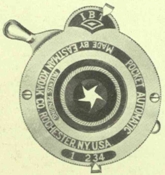
This shutter has star shaped opening and is automatic in action. It works with finger release for bulb, time and instantaneous exposures and is perfectly reliable in every respect. Fitted with iris diaphragm stops and regularly supplied with Nos. 1 and 1A Folding Pocket Kodaks, and Nos. 2 and 2A Folding Pocket Brownies.
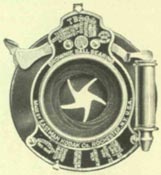
The ball bearing type of shutter has been found so accurate and reliable that we have designed a shutter on the ball bearing principle for the 3 and 3A Folding Brownie cameras.
This shutter is well made in every respect, it works with bulb and tube or finger release, and is fitted with the Kodak Autotime Scale—a great help for amateur photographers, especially beginners.
The Brownie Ball Bearing shutter works not only for time and bulb exposures, but has variable indicated speeds of 1/25, 1/50 and 1/100 second. It is fitted with iris diaphragm and supplied with the Nos. 3 and 3A Folding Brownie cameras.
For a more complete description of the Kodak Autotime Scale supplied with this shutter, see page 8.
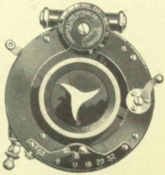
The Compound shutter is an automatic and setting shutter combined. Automatically, either time or bulb exposures may be made, while it may be set for speeds of from 1 to 1/150, 1/200 and 1/250 second, according to size of shutter. The shutter leaves are formed of segments opening in star shape, giving even illumination over the entire plate the instant the exposure is started, and an iris diaphragm is supplied for stopping down.
Case is made of aluminum, and accurate adjustments can be made with the shutter in any position.
Regularly supplied on the Nos. 1A, 3, 3A Special and Six-Three Kodaks and as a special equipment with the Nos. 4 and 4A Folding Kodaks.
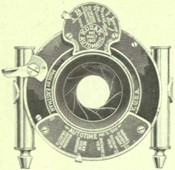
The Kodak Automatic shutter is carefully adjusted for time, bulb and instantaneous exposures. It is also graduated for fractional parts of a second, and is unusually accurate.
This shutter is fitted with the Kodak Autotime scale and is supplied as a special equipment on the Nos. 1A, R. R. Type; 3, 3A and 4 Folding Pocket Kodaks.
The Scale greatly reduces the liability of error in exposure, as it automatically indicates the proper time and stop opening for subjects under any condition of outdoor photography. It is exceedingly simple to use. The speed indicator is merely set at the point on the scale indicating the kind of light prevailing and the diaphragm indicator at the point indicating the character of the subject.
These scales are also supplied at a nominal charge for the following shutters when fitted with double lenses only, and can be readily attached by any amateur. Always order by Style letter.
Style A. For use with Kodak Ball Bearing shutter, 2½ × 4¼ and 3¼ × 4¼.
Style AA. For Kodak Ball Bearing shutter, 3 × 5¼, 3¼ × 5½ and 4 × 5.
Style B. For use with F. P. K. Automatic, 2½ × 4¼ and 3¼ × 4¼, No. 1 S. V. (Blair or Premo) Automatic, or No. 1 B. & L. S. V. Automatic shutters.
Style BB. For use with F. P. K. Automatic, 3¼ × 5½ and 4 × 5, No. 2 S. V. (Blair or Premo) Automatic, or No. 2 B. & L. S. V. Automatic shutters.
Style C. For use with Kodak Automatic shutter, 3¼ × 4¼.
Style CC. For use with Kodak Automatic shutter, 3¼ × 5½ and 4 × 5.

Style D. For B. & L. Automatic and Century Automatic shutters, 3¼ × 4¼.
Style DD. For use with B. & L. Automatic and Century Automatic shutters, 3¼ × 5½ and 4 × 5.
Style DDD. For use with B. & L. Automatic shutter, 4¼ × 6½.
Style I. For use with Kodak Ball Bearing shutter, 2¼ × 3¼.
Price, any of above styles, $1.00.
Style H. For use with No. 0, 3¼ × 4¼ Compound shutter.
Style HH. For use with No. 1, 3¼ × 5½ and 4 × 5 Compound shutter.
Style HHH. For use with No. 2, 4¼ × 6½ and 5 × 7 Compound shutter.
Price for any style Compound shutter, $1.50.
The regular R. R. and meniscus lenses used on Kodak and Brownie Cameras have always been the best lenses of their respective types that could be secured. These lenses are perfectly adapted to everyday amateur photography, producing pictures under normal light conditions that leave nothing to be desired by the average amateur.
For those, however, who wish even greater efficiency and capabilities, we supply the anastigmat lens equipments.
The superiority of the anastigmat lens, without attempting to go into the technicalities of the subject, consists of—Perfect definition over the whole negative, absolute flatness of field, and higher speed.
In R. R. lenses the tendency to lack of definition toward the edges, which always occurs in an uncorrected lens, is so slight as to be unnoticeable except to the most expert eye. In a true anastigmat, it is entirely eliminated.
The speed of a lens is determined by the relative size of the diaphragm opening. An R. R. lens cannot be used at an opening greater than ⅛ its focal length, commonly designated as f. 8. But an anastigmat lens can be so corrected as to permit the use of larger diaphragm openings and still produce sharp, clear negatives. This larger opening admits more light within a given time than that of the R. R. lens, hence the anastigmat is much faster. Thus the Zeiss or Cooke Kodak Anastigmat lens, working at an aperture of f. 6.3 admits 60 per cent. more light in a given time than does the R. R.
This speed advantage enables the user to make short exposures on dull days or under poor light conditions, where hopelessly undertimed negatives would result with an R. R. lens. And under proper conditions, exposures up to 1/250 second with a Compound shutter and 1/1000 with a focal plane shutter, can be made with the anastigmat.
In the last few years there has been a steadily increasing interest in and demand for anastigmat lens equipments among amateur photographers, and we responded to this demand, first by furnishing the Special Kodaks fitted with Zeiss Kodak Anastigmat lens, f. 6.3—a lens fully corrected and offering the advantage of high speed.
These have been followed by the Six-Three Kodaks. These differ from the Specials in that they are simply our regular Kodak models, without the special covering and finish of "Specials," and fitted with anastigmat lenses specially designed by Taylor, Taylor & Hobson, for Kodak use and called the Cooke Kodak Anastigmat. This lens works at f. 6.3 and is fully corrected in every particular.
The extraordinary popularity of the Vest Pocket Kodak is due not alone to its compactness—it is so flat and smooth and small that it will readily slip into a vest pocket—but also to the excellent quality of its pictures, whether printed by contact or enlarged.
In fact, this little camera in itself is so very desirable and of such general utility, that we furnish it with several different equipments to meet any demand.
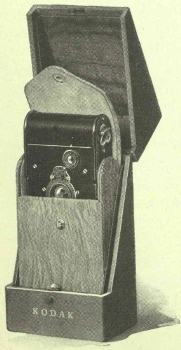
For average photography, the camera fitted with Kodak Ball Bearing shutter and tested meniscus achromatic lens is amply efficient, for it will make excellent pictures under ordinary conditions.
For those who want the microscopic definition of the anastigmat, we offer the Vest Pocket Kodak, this year, fitted with the new Kodak Anastigmat lens. This lens works at f. 8, it is fully corrected, and made of the first quality of Jena glass. This makes a most desirable outfit at a surprisingly low price for an anastigmat equipment.
Then for those who want not only the absolute sharpness and flatness of field, but the maximum of speed as well, we offer the camera fitted with Zeiss Kodak Anastigmat lens, f. 6.9.
The appearance of the Vest Pocket Kodak is so suggestive of quality, that it makes an ideal camera for gift purposes on holidays, birthdays, at graduation time, and such occasions. For these purposes we have devised the Kodak Gift Case shown in the illustration. The Vest Pocket Kodak in this case is fitted with Kodak Anastigmat lens, f. 8. The carrying case is of imported satin finish leather, in a shade of soft brown that is in perfect harmony with the deep blue of the handsome silk-lined container. The whole outfit possesses a quality and richness that will appeal to the most fastidious.
The Vest Pocket Kodak with any equipment is always ready for action. It is only necessary to pull out the front to its full extent, and the camera is in focus for objects at any distance. The shutter is automatic, and a convenient reversible finder, for composing the view in either horizontal or vertical position, is provided.
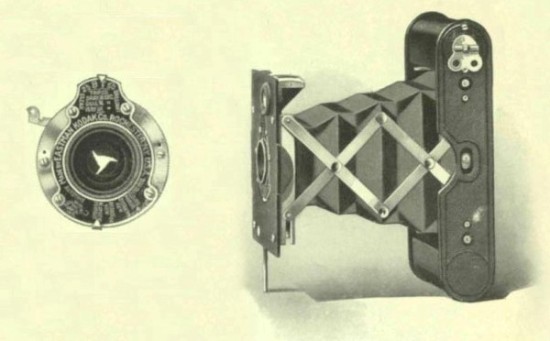
Another feature is the extreme simplicity in loading—nothing trappy or fussy about it. Indeed, the operation of the camera is simple in every detail, nothing in the way of simplicity or efficiency having been sacrificed in order to reduce the size.
In Detail
For rectangular pictures, 1⅝ × 2½ inches. Capacity, 8 exposures without reloading. Size of Kodak, 1 × 2⅜ × 4¾ inches. Weight, 9 ounces. Lens, regular, meniscus achromatic, 3-inch focus. Special, Zeiss Kodak Anastigmat f. 6.9, or Kodak Anastigmat f. 8. Shutter, Kodak Ball Bearing No. 0. Brilliant reversible finder. All metal body, black enamel finish and black leather bellows.
The Price
| Vest Pocket Kodak, meniscus achromatic lens and Kodak Ball Bearing shutter | $7.00 | |
| Vest Pocket Kodak with Kodak Anastigmat lens f. 8 and Kodak Ball Bearing shutter | 13.50 | |
| Kodak Gift Case, includes Vest Pocket Kodak with Kodak Anastigmat lens f. 8, imported satin finish leather case and silk-lined container | 16.50 | |
| Vest Kodak, Special, Zeiss Kodak anastigmat lens, and Kodak Ball Bearing shutter | 22.50 | |
| Leather Case for Vest Pocket Kodak | .75 | |
| Grain Leather Case for Vest Pocket Kodak Special | 1.50 | |
| Imported Satin Finish Leather Case | 3.00 | |
| Hand Bag for Vest Pocket Kodak | .25 | |
| De Luxe bag, suede calfskin, long straps | 1.75 | |
| N. C. Film Cartridge, 8 exposures, 1⅝ × 2½ (No. 127) | .20 | |
| Kodak Portrait Attachment | .50 |
So complete and varied has the Kodak line become, so altogether simple is the operation of each camera, that each year it looks well nigh impossible to strengthen the line or broaden the selection for the amateur.
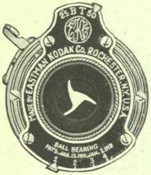
However, the Kodak policy of never letting well enough alone has developed two most attractive new models this year, which round off the whole line, being built upon the idea of providing genuine daylight-all-the-way Kodaks, with all the Kodak convenience and dependability, for those who wish to take up photography at the minimum of expense.
The first of these models, the No. 1 Kodak Junior, makes 2¼ × 3¼ pictures and loads with the Kodak Film cartridge of six exposures (No. 120). And for loading and unloading, the back of the camera is constructed upon a new principle which makes it unusually easy to remove.
A striking feature of this camera is its extreme thinness and all-around compactness. It will readily slip into the pocket, and yet it is fully equipped for efficient work in all branches of general amateur photography. It is fitted with the No. 0 Ball Bearing shutter, speed 1/50 of a second, with cable release, as described on page 6, and offers the choice of rapid rectilinear or meniscus achromatic lens. All lenses fitted to this camera must stand the usual rigid Kodak tests.
The No. 1 Kodak Junior is provided with automatic focusing lock, collapsible reversible finder, two tripod sockets—in fact, the practical, convenient working equipment which one expects in a true Kodak.
The camera is well made in every respect, it is covered with a good quality of grain leather, and the metal parts are finished in nickel and black enamel.
The low price means no stinting in either material or workmanship. It is only possible through the perfection of our scientific factory organization and the large quantities which our large distribution enables us to make at one time.
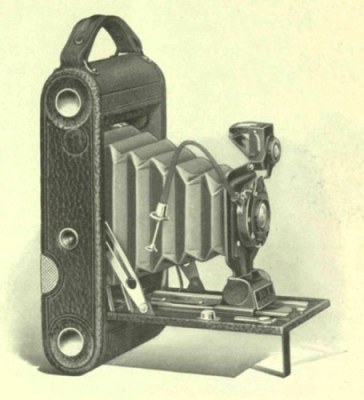
In Detail
For rectangular pictures. 2¼ × 3¼ inches. Capacity, 6 exposures without reloading. Size of Kodak, 17⁄16 × 3⅝ × 6⅝ inches. Weight, 23 ounces. Lens, meniscus achromatic, 4¼-inch focus. Also supplied with rapid rectilinear lens if desired. Shutter, Kodak Ball Hearing No. 0, with cable release. (See page 6.) Brilliant, reversible, collapsible finder. The film cartridge for this camera is the same as the one used for No. 2 Brownie and not for No. 1 Folding Pocket Kodak.
The Price
| No. 1 Junior, Kodak with meniscus achromatic lens and Kodak Ball Bearing shutter | $7.50 | |
| Ditto, with R. R. lens | 9.00 | |
| Black Sole Leather Case, with strap | 1.50 | |
| Kodak Autotime Scale (Style 1, for use with the camera when fitted with R. R. lens only) | 1.00 | |
| N. C. Film Cartridge, 6 exposures (No. 120) | .20 | |
| Kodak Portrait Attachment | .50 |
In this new model is offered the advantages of low cost, with Kodak efficiency, which we have seen in the No. 1 Kodak Junior, in a camera made upon the same principle for 2½ × 4¼ pictures.
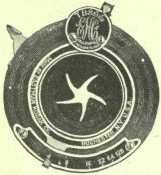
This is one of the most popular amateur sizes, the proportion being unusually pleasing for landscapes, street scenes, and the like, in the horizontal position, and admirably adapted for portraiture when used vertically.
With its strikingly thin, compact form, its reliable equipment and its low cost, the No. 1A Kodak Junior is sure to please anyone who prefers pictures of this size.
This model will accommodate the regular twelve exposure Kodak N. C. Film cartridges, and thus offers the daylight-all-the-way feature of all Kodaks.
The shutter is the Kodak Ball Bearing with cable release, which works not only for bulb and time exposures, but has variable indicated speeds of 1/25, 1/50 and 1/100 second. The leaves, opening in the shape of a star, admit the greatest possible amount of light, for a between-the-lens shutter, at each exposure.
The camera is furnished with either meniscus achromatic or rapid rectilinear lens. In both cases the lens is carefully tested and must conform to the high Kodak standard before it is allowed to go on the camera.
Simplicity marks this camera in every respect. It is made with the new style back—unusually easy to remove for loading and unloading. It has an automatic focusing lock, which permits the camera to be brought to focus quickly for objects at any distance. The finder is of the new collapsible type; it is reversible, and two tripod sockets are furnished, so that the camera may be easily used in either the vertical or horizontal position.
So compact that it will readily slip into the pocket, this camera offers that high standard of efficiency which is inseparable from the Kodak idea. The back and bed are made of aluminum, the covering is genuine leather, and metal parts are finished in nickel and black enamel.
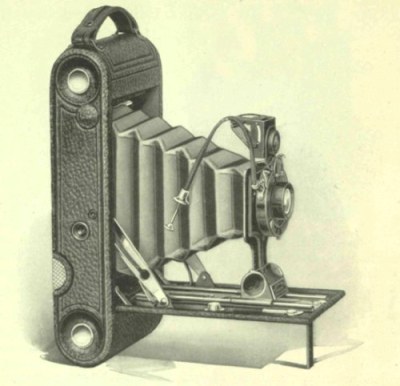
In Detail
For rectangular pictures, 2½ × 4¼ inches. Capacity, 12 exposures without reloading. Size of Kodak, 1⅝ × 3¾ × 8 inches. Weight, 28 ounces. Lens, meniscus achromatic, 5-inch focus. Also supplied with R. R. lens if desired. Shutter, Kodak Ball Bearing with cable release. (See page 6.) Brilliant, reversible, collapsible finder.
The Price
| No. 1A Kodak Junior, with meniscus achromatic lens and Kodak Ball Bearing shutter | $9.00 | |
| Ditto, with R. R. lens | 11.00 | |
| Black Sole Leather Case, with strap | 1.50 | |
| Kodak Autotime Scale (Style A, for use with camera when fitted with double lens only) | 1.00 | |
| N. C. Film Cartridge, 12 exposures (No. 116) | .50 | |
| Ditto, 6 exposures | .25 | |
| Kodak Portrait Attachment | .50 |
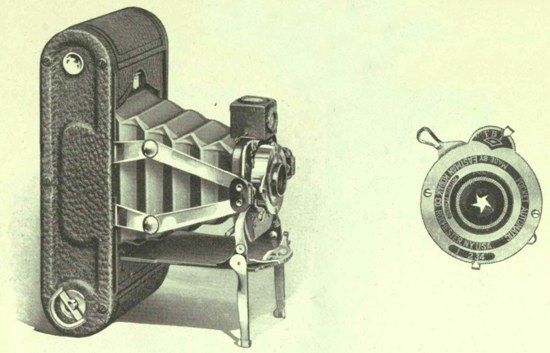
These little Kodaks are designed for those who wish compact folding cameras which can be easily carried in the pocket and which will make pictures without the necessity of focusing or estimating distances.
Upon opening the camera the front springs automatically into position, ready at once for making pictures of objects at any distance. A reversible finder makes composition easy, and slight pressure of the shutter lever makes the exposure.
When closed the bed folds over front and bellows, concealing all adjustments, and the camera can then be very conveniently carried in any coat pocket. The camera is made of aluminum, with best seal grain leather covering and has nickel fittings. They differ only in the size of the pictures they make.
In Detail
For rectangular pictures, No. 1, 2¼ × 3¼ inches; No. 1A, 2½ × 4¼ inches. Capacity, each 12 exposures without reloading. Size of Kodak, No. 1, 1⅝ × 3½ × 6¾ inches; No. 1A, 1¾ × 3⅞ × 7¾ inches. Weight, No. 1, 16 ounces; No. 1A, 22 ounces. Lens, meniscus achromatic, No. 1, 4-inch focus; No. 1A, 5-inch focus. Shutter, Pocket Automatic. (See page 6.) Brilliant reversible finder.
The Price
| No. 1 | No. 1A | |||
| Folding Pocket Kodak, with meniscus achromatic lens, Pocket Automatic shutter | $10.00 | $12.00 | ||
| Black Sole Leather Case, with shoulder strap | 1.50 | 1.50 | ||
| N. C. Film Cartridge, 12 exposures (No. 105 for No. 1, No. 116 for No. 1A) | .40 | .50 | ||
| Ditto, 6 exposures | .20 | .25 | ||
| Kodak Portrait Attachment | .50 | .50 |

This is a camera of greater capabilities and wider scope than those previously described—the first of that series of double lens Kodaks which have played such a prominent part in the development and popularization of amateur photography.
These cameras are fitted with the best R. R. lenses to be had, each one carefully tested to the highest standard and fitted only if it conforms to that standard. The shutter is of the Kodak Ball Bearing type.
The camera as a whole makes a compact, inexpensive outfit, considering its capabilities, and one which, though suitable for the most serious work, will slip readily into the pocket, and is so simple that it may be effectively handled by the beginner.
In Detail
For rectangular pictures, 2½ × 4¼ inches. Capacity, 12 exposures without reloading. Size of Kodak, 8 × 2 × 3¾ inches. Weight. 26 ounces. Lens, double combination, rapid rectilinear, speed, f. 8, focal length, 5 inches. Shutter, Kodak Ball Bearing. (See page 6.) Automatic focusing lock. Two tripod sockets. Brilliant reversible finder.
The Price
| No. 1A F.P.K., R.R. Type, R.R. lens, Kodak Ball Bearing shutter | $15.00 | |
| Ditto, with Kodak Automatic shutter | 20.00 | |
| Black Sole Leather Carrying Case, with strap | 1.50 | |
| Kodak Autotime Scale (Style A) | 1.00 | |
| N. C. Film Cartridge, 12 exposures, 2½ × 4¼ (No. 116) | .50 | |
| Ditto, 6 exposures | .25 | |
| Kodak Portrait Attachment | .50 |
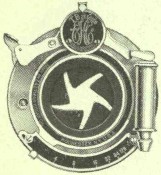
These cameras are made for two standard amateur size pictures and are similar in every essential respect excepting in the matter of size. The No. 3 makes 3¼ × 4¼ pictures—a favorite with many, and especially suitable for lantern slide making, as the slide can be printed by direct contact. The No. 4 makes 4 × 5 pictures and is preferred by many on account of the comparatively large size which it is possible to get of the objects in the composition.
Both cameras offer the usual Kodak simplicity, and the exceptional lens and shutter equipment which assures the user the maximum of efficiency in all work where an anastigmat equipment is not necessary. The illustration on the opposite page shows the No. 3.
The shutter is the Kodak Ball Bearing, in which is mounted an R. R. lens which must stand the most rigid test before it is passed by our inspectors. This lens works at f. 8, and as the leaves of the Kodak Ball Bearing shutter open in the shape of a star, the greatest possible amount of light is admitted at this opening—a fact which makes the instruments especially valuable for snap-shot work.
The cameras are equipped with rising and sliding front—a great convenience in architectural and many forms of landscape photography, and an automatic focusing lock is provided so that either can quickly be brought to focus at any-distance.
While these models, of course, are designed for the use of our roll films, either can be loaded with plates at any time by the addition of a simple plate adapter or combination back (supplied extra). This is interchangeable with the regular back, is provided with ground glass for focusing and takes double plate holders. (See similar back illustrated on page 20.)
Both cameras are handsomely finished throughout. Back and bed are of aluminum, metal parts are highly nickeled, and covering is of fine quality grain leather.
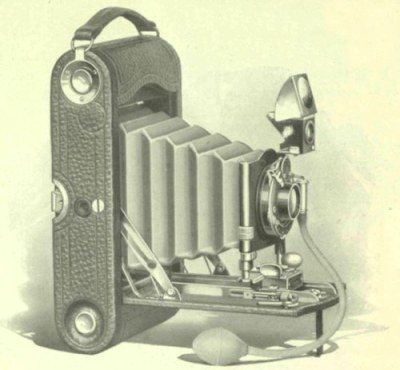
In Detail
For rectangular pictures. No. 3, 3¼ × 4¼ inches; No. 4, 4 × 5 inches. Capacity, 12 exposures without reloading. Size of Kodak, No. 3, 1¾ × 4½ × 7½ inches: No. 4, 2¼ × 5¾ × 9 inches. Weight, No. 3, 23 ounces: No. 4, 2 pounds 11 ounces. Lens, double combination, rapid rectilinear, speed. f. 8, focal length. No. 3, 5 inches: No. 4, 6¾ inches. Shutter, Kodak Ball Bearing. (See page 6.) Rising and sliding front. Two tripod sockets. Brilliant reversible finder with hood. Automatic focusing lock.
The Price
| No. 3 | No. 4 | |||
| F. P. Kodak., R. R. lens and Kodak Ball Bearing shutter | $17.50 | $20.00 | ||
| Ditto, with Kodak Automatic shutter | 22.50 | 25.00 | ||
| Ditto, with Compound shutter, highest speed 1/200 second and Zeiss Kodak Anastigmat lens, f. 6.3 | 57.00 | |||
| Kodak Autotime Scale (Style A for No. 3, Style AA for No. 4) | 1.00 | 1.00 | ||
| Black Sole Leather Case, with strap | 1.75 | 2.00 | ||
| Combination Back, with ground glass | 3.50 | 3.50 | ||
| Double Glass Plate Holders | 1.00 | 1.00 | ||
| N. C. Film Cartridge. 12 exposures (No. 118 for No. 3. No. 123 for No. 4) | .70 | .90 | ||
| Ditto, 6 exposures | .35 | .45 | ||
| Ditto, "double-two" cartridge, 4 exposures | .25 | .30 | ||
| Kodak Portrait Attachment | .50 | .50 |

The best thought of our manufacturing organization has been put into presenting in this model a moderate priced camera for general amateur photography that is the embodiment of skill and painstaking care.
It has in fact come to be recognized as the standard in hand cameras, and every suitable improvement made, or new idea evolved in the years in which it has been on the market, has been incorporated in its construction.
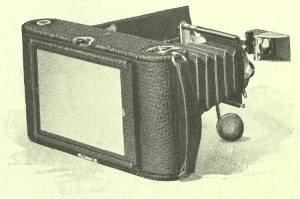
The 3A Folding Pocket Kodak was the first camera made for 3¼ × 5½ pictures—a size which has become the most popular of all amateur sizes. Its proportions are just right for post cards, it is unusually effective for landscapes and street scenes when used horizontally; while vertically, it is ideal for portraiture, whether full length or head and shoulders, when the camera is fitted with Kodak Portrait Attachment.
The camera is fitted with tested R. R. lens, the Kodak Ball Bearing shutter, and rising and sliding front. And it is so simple that a beginner can make good pictures with it from the start.
Like the No. 3, this model will accommodate plates as well as films by the simple addition of a combination back, which is interchangeable with the regular back. This may be secured from any dealer, it is fitted with ground glass and takes double plate holders.
This camera is covered with best quality of fine grain leather, and has nickeled fittings.

In Detail
For rectangular pictures, 3¼ × 5½ inches. Capacity, 10 exposures without reloading. Size of Kodak, 9½ × 4¾ × 2 inches. Weight, 41 ounces. Lens, double combination, rapid rectilinear, speed, f. 8, focal length, 6¾ inches. Shutter, Kodak Ball Bearing. (See page 6.) Two tripod sockets. Brilliant reversible finder with hood. Automatic focusing lock.
The Price
| No. 3A F. P. Kodak, R. R. lens, Kodak Ball Bearing shutter | $20.00 | |
| Ditto, with Kodak Automatic shutter | 25.00 | |
| Black Sole Leather Case, with strap | 2.00 | |
| Kodak Automatic Scale (Style AA) | 1.00 | |
| Combination Back | 3.50 | |
| Double Glass Plate Holders, 3¼ × 5½, each | 1.00 | |
| N. C. Film Cartridge, 10 exposures, 3¼ × 5½ (No. 122) | .70 | |
| Ditto, 6 exposures | .40 | |
| Ditto, "double-two" cartridge, 4 exposures | .30 | |
| Kodak Portrait Attachment | .50 |
For very large size pictures, we offer the No. 4A Folding Kodak—a camera which combines all the simple and convenient Kodak features in a very light and compact camera, considering the size of the pictures it makes. It is fully equipped for out-of-the-ordinary work, as well as for snap-shot and general amateur photography.
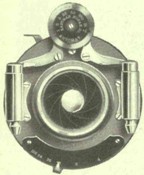
One of its special features is its adaptability to home portraiture. Fitted with the Kodak Portrait Attachment, it will make bust portraits up to the full size of the film, as it may be operated as close as 3½ feet to the subject. A plate adapter (extra) with focusing screen, interchangeable with the regular back, will permit the use of dry plates if desired.
The shutter supplied with this model is a double valve automatic, which works not only for time and bulb exposures, but is also graduated in fractional parts of a second from 1/100 to 1. The lens is a Rapid Rectilinear of the same high quality as those supplied with the preceding Kodaks.
The camera is equipped with rising and sliding front, rack and pinion for easy focusing, two tripod sockets and a very positive automatic standard clamp. The regular finder is a brilliant reversible, but when desired, a direct view finder can be furnished for specially quick snap-shot work with the camera held on a level with the eyes.
Constructed with the same care and attention to detail as the preceding model, the No. 4A is just as simple to operate, and is finished in the same style, with seal grain covering and nickeled fittings.
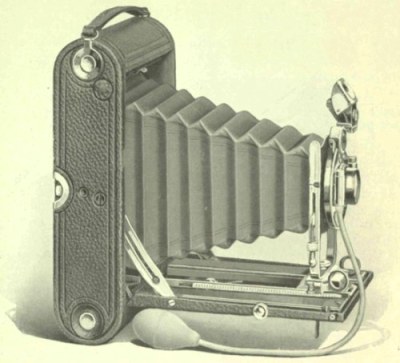
In Detail
For rectangular pictures, 4¼ × 6½ inches. Capacity, 6 exposures without reloading. Size of Kodak, 11×6½×2⅝ inches. Weight, 4 pounds 4 ounces. Lens, double combination, rapid rectilinear, speed, f. 8, focal length, 8¼ inches. Shutter, B. & L. Automatic. Rising and sliding front. Rack and pinion for focusing. Two tripod sockets. Brilliant reversible finder with hood.
The Price
| No. 4A F. Kodak. R. R. lens. B. & L. Automatic shutter | $35.00 | |
| Ditto, with Zeiss Kodak anastigmat lens, f. 6.3 | 67.00 | |
| Ditto, with Compound Shutter, highest speed 1/150 second | 77.00 | |
| Kodak Autotime Scale for regular equipment (Style DDD) | 1.00 | |
| Ditto, for Compound Shutter (Style HHH) | 1.50 | |
| Black Sole Leather Case, with strap | 2.50 | |
| Glass Plate Adapter, with ground glass | 5.00 | |
| Double Glass Plate Holders, each | 1.25 | |
| N. C. Film Cartridge, 6 exposures, 4¼ × 6½ (No. 126) | .65 | |
| Ditto, "double-two" cartridge, 4 exposures | .45 | |
| Direct View Finder | 2.00 | |
| Kodak Portrait Attachment | .50 |
The Panoram Kodak does a special kind of work—a very desirable kind of work which cannot be done with a camera of any other type.
As its name implies, it is constructed so as to take panoramic pictures of outdoor groups, landscapes, mountain views, and the like.
For instance, in making a picture of an outdoor group of twelve or fifteen people, with an ordinary camera, they would have to be arranged in two or three rows to get good sized images, but with a Panoram they can be arranged in a semi-circle, at a given distance from the camera, and all appear in the picture in one row and of the proper relative size. Again, in making a landscape, the sweep of the Panoram lens will take in the complete view, while the scope of the ordinary camera could only permit a portion of it to be taken at one exposure.
In addition to its use for making horizontal pictures, the camera may be as easily used in the vertical position, and decidedly unique pictures of high waterfalls, mountain peaks and such subjects can be secured.
The lens is mounted on a pivot and when the exposure is to be made, by pressing a lever the lens automatically swings on this pivot from one side of the camera to the other, embracing an angle of over 100 degrees. At the same time, the shutter operates automatically with great precision, insuring even illumination throughout the exposure.
There is no complication whatever in operation, the whole process is automatic; it's just as easy to make pictures with the Panoram as with any other Kodak.
Those who already have other Kodaks or contemplate purchasing such, will find this a valuable addition to their photographic equipment for the making of out-of-the-ordinary pictures.
Panoram Kodaks use the regular daylight loading N. C. Kodak film, they are carefully made, have genuine leather coverings and nickeled fittings.
The No. 1 has a scope of 112 degrees, while the No. 4 embraces an angle of 142 degrees. Panoram Kodaks cannot be used successfully indoors.

No. 1 Panoram Kodak
In Detail
For rectangular pictures, 2¼ × 7 inches. Capacity, 6 exposures without reloading. Size of Kodak, 3⅜ × 4⅜ × 7⅜ inches. Weight, 24 ounces. Lens, specially selected as to quality and focal length. Shutter, Panoram. Two tripod sockets. Brilliant finder with hood. Uses No. 1 F. P. Kodak cartridges.
The Price
| No. 1 Panoram Kodak | $10.00 | |
| Black Sole Leather Carrying Case, with shoulder strap | 2.50 | |
| N. C. Film Cartridge, 6 exposures, 2¼ × 7 (No. 105) | .40 | |
| Ditto, 3 exposures | .20 |
No. 4 Panoram Kodak
In Detail
For rectangular pictures, 3½ × 12 inches. Capacity, 4 exposures without reloading. Size of Kodak, 4¾×5⅝×10⅛ inches. Weight. 2 pounds 14 ounces. Lens, specially selected as to quality and focal length. Shutter, Panoram. Two tripod sockets. Brilliant finder with hood. Uses No. 4 B. E. cartridges.
The Price
| No. 4 Panoram Kodak | $20.00 | |
| Black Sole Leather Carrying Case, with shoulder strap | 3.00 | |
| N. C. Film Cartridge, 4 exposures, 3½ × 12 (No. 103) | .75 | |
| Ditto, 2 exposures | .45 |
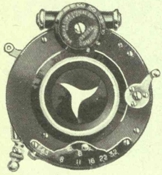
The Special Kodaks are made upon the idea of providing the very best possible in hand cameras. A fine anastigmat lens, made expressly for hand camera work, a high speed, accurate shutter, a complete operating equipment, and the best materials procurable, richly finished—these, moulded together by the most expert camera workmen in the world, leave nothing to be desired by the user, whether he be beginner or expert.
Aside from the requirements of the focal plane specialist, there is no condition under which amateur pictures can be made, in which these cameras will not produce the best possible results.
The Nos. 1A and 3 Specials are alike in every respect excepting in size—the No. 1A making 2½ × 4¼ pictures and the No. 3 the larger 3¼ × 4¼ size.
Each is fitted with the Zeiss Kodak Anastigmat lens working at a maximum opening of f. 6.3, and with the Compound shutter attaining a speed of 1/250 second. The fast lenses give the Specials a great advantage over the ordinary camera in dull lights, and in combination with the Compound shutter, make them second only to cameras having focal plane shutters for photographing rapidly moving objects.
They have rising and sliding fronts, reversible finders, rack and pinion for focusing, spirit levels, in fact every useful convenience that can be put into a hand camera. The No. 3 size will take plates by addition of a combination back (supplied extra).
Made as the last word in photographic perfection, these cameras are beautifully finished. Covered with genuine Persian Morocco, with rich black leather bellows and nickeled fittings, they bear the impress of the quality that is in them.
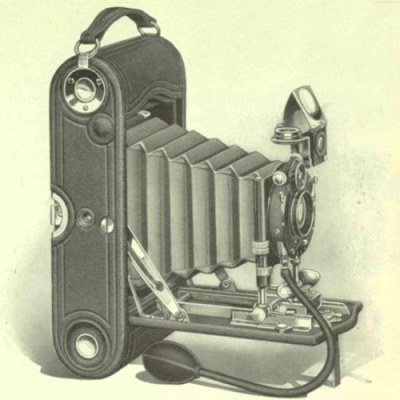
In Detail
Size of Kodak. No. 1A, 2×3¾×8 inches; No. 3, 1⅞×4½×8 inches. Weight, No. 1A, 30 ounces; No. 3, 32 ounces. Lens, Zeiss Kodak anastigmat, speed, f. 6.3, focal length. No. 1A, 5 inches; No. 3, 5 inches. Shutter, Compound. (See page 7.) Two tripod sockets. Brilliant reversible finder, with hood. Spirit level. Rack and pinion for focusing.
The Price
| No. 1A 2½ × 4¼ | No. 3 3¼ × 4¼ | |||
| Special Kodak, Zeiss Kodak anastigmat lens, f. 6.3, and Compound Shutter | $46.00 | $48.00 | ||
| Ditto, with Cooke Series IIIa, f. 6.5 lens | 56.50 | 58.50 | ||
| Ditto, with B. & L. Zeiss Tessar Series IIb lens, f. 6.3 | 56.50 | 58.50 | ||
| Kodak Autotime Scale (Style H) | 1.50 | 1.50 | ||
| Grain Leather, Velvet Lined Case, with strap | 3.00 | 3.00 | ||
| Combination Back | 4.00 | |||
| Double Glass Plate Holders, each | 1.00 | |||
| N. C. Film Cartridge, 12 exposures (No. 116 for No. 1A, No. 118 for No. 3) | .50 | .70 | ||
| Ditto, 6 exposures | .25 | .35 | ||
| Ditto, "double-two" cartridge, 4 exposures | .25 | |||
| Kodak Portrait Attachment | .50 |
To combine in one instrument every feature that could add to practical efficiency and yet retain the pocket Kodak convenience and simplicity was the work that we set for ourselves in designing the 3A Special Kodak. In no respect did we fall short of that work. In this camera no essential to good picture making is omitted, yet it has no unnecessary "contraptions" to annoy and befog the beginner. It is recognized as the highest type of hand camera for the amateur—skilled or unskilled.

The 3A Special Kodak is equipped with the Zeiss Kodak Anastigmat lens, f. 6.3, the anastigmat made especially for hand camera work and combining speed, depth and definition in an unusual degree. The shutter is the Compound, operated by either cable or finger release and having a maximum speed of 1/200 second.
With this equipment it is possible to get well-timed pictures, under light conditions that would be fatal to good results with the ordinary camera and in bright light to make successful exposures as short as 1/200 second.
The 3A Special has a most complete equipment in keeping with the high grade of work for which it is designed. It has both rising and sliding front, reversible finder, rack and pinion for focusing, spirit level, double focusing scale—one for films and the other for plates.
The camera body is made of aluminum, producing a very light, yet strong and durable, instrument. The finish and appointments are of the richest. The covering is genuine Persian Morocco, the bellows is of black selected leather, and these in connection with the highly nickeled fittings and dull black enameled shutter add that look of quality that is in harmony with its genuine efficiency and worth.
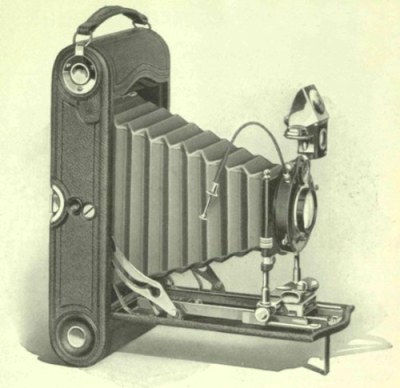
In Detail
Size of Kodak, 9½ × 4¾ × 2 inches. Weight, 42 ounces. Lens, Zeiss Kodak anastigmat, speed, f. 6.3, focal length, 6¾ inches. Shutter, Compound, with cable release. (See page 7.) Two tripod sockets. Brilliant reversible finder, with hood. Spirit level. Rack and pinion for focusing.
The Price
| No. 3A Special Kodak, Zeiss Kodak anastigmat lens. f. 6.3 and Compound shutter | $60.00 | |
| Ditto, with Cooke Series IIIa f. 6.5 lens | 66.50 | |
| Ditto, with B. & L. Zeiss Tessar Series IIb lens, f. 6.3 | 71.00 | |
| Kodak Autotime Scale (Style HH) | 1.50 | |
| Grain Leather, Velvet Lined Case, with strap | 3.50 | |
| Combination Back | 4.00 | |
| Double Glass Plate Holders, each | 1.00 | |
| N. C. Film Cartridge, 10 exposures (No. 122) | .70 | |
| Ditto, 6 exposures | .40 | |
| Ditto, "double-two" cartridge, 4 exposures | .30 | |
| Kodak Portrait Attachment | .50 |
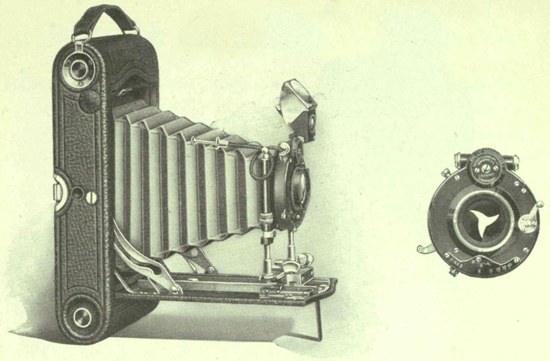
From the time that the Kodak catalogue appeared last year, containing the first announcement of the Six-Three Kodaks, it was evident that these cameras were to score a great success. The demand for them grew, as it were, over night, and has steadily kept up ever since.
This is a natural enough condition, when it is considered that Six-Three Kodaks provide those who want the anastigmat advantages of definition, flatness of field, and speed, at the minimum of expense, with suitably equipped and fully reliable cameras.
To produce such cameras we have taken the regular Folding Pocket Kodak models and replaced the R. R. lens and Ball Bearing shutter equipments with the Compound shutter with cable release and the Cooke Kodak anastigmat lens. This lens is an anastigmat of first quality, fully corrected and working at a maximum speed of f. 6.3.
For other details on any Six-Three Kodak, merely refer to the detailed specifications of the corresponding regular model.
The Price
| Six-Three Kodak No. 1A, 2½ × 4¼, Cooke Kodak anastigmat lens, f. 6.3, and Compound shutter, highest speed 1/250 second | $37.00 | |
| Six-Three Kodak No. 3, 3¼ × 4¼, Cooke Kodak anastigmat lens, f. 6.3, and Compound shutter, highest speed 1/250 second | 39.00 | |
| Six-Three Kodak No. 3A, 3¼ × 5½, Cooke Kodak anastigmat lens, f. 6.3, and Compound shutter, highest speed 1/250 second | 48.00 | |
| Kodak Autotime Scale (Style H for Nos. 1A and 3, Style HH for No. 3A) | 1.50 |
For prices on carrying cases, films, etc., see price list of corresponding regular models.
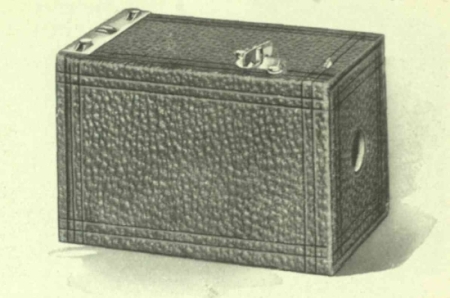
This, the first of the Brownies, is really responsible for the entire line of these popular cameras. Originally produced as a camera particularly for the children, the No. 1 Brownie made such good pictures in their hands as to excite the interest of grown-up people, and the success obtained by its use created a demand for similar inexpensive cameras for pictures of larger size. The No. 1 Brownie is exceedingly simple to operate and each camera has to undergo the regular Kodak inspection, before being sent out.
The scope of view is ordinarily located by V-shaped lines at the top, but if preferred the Brownie finder (detachable) illustrated below, can be fitted at an extra charge of 25 cents.
Has automatic shutter for time or snap-shot exposures, and will make good portraits when fitted with Kodak Portrait Attachment.
In Detail
For square pictures, 2¼ × 2¼ inches. Capacity, 6 exposures without reloading. Size of camera, 4⅞ × 3⅛ × 3 inches. Weight, 8 ounces. Lens, meniscus, 3¾-inch focus. Shutter, Eastman Rotary, with one stop.

The Price
| No. 1 Brownie Camera, meniscus lens. Eastman Rotary shutter | $1.00 | |
| No. 1 Brownie Carrying Case, holds camera and finder | .50 | |
| N. C. Film Cartridge, 6 exposures, 2¼ × 2¼ (No. 117) | .15 | |
| Brownie Finder, detachable | .25 | |
| No. 1 Brownie Developing and Printing Outfit, including paper for 24 prints | .90 | |
| Kodak Portrait Attachment | .50 |
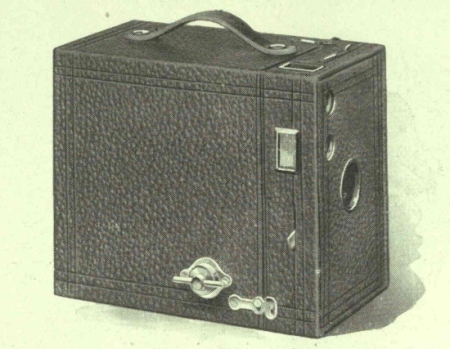
Simple, sturdy, reliable, these inexpensive little cameras have stood the test of years, and will be found in the hands of many thousands of people all over the world, who are making perfectly satisfactory pictures with them. They are especial favorites with the children on account of their great simplicity, but they are withal so practical that they have been readily taken up by grown-up people who wish to make pictures in the easiest possible manner and at the minimum of expense.
Each has two finders, automatic shutter, carefully tested lens, and imitation leather covering. They differ from each other only in the size of the pictures they make and in their lenses.
In Detail
For rectangular pictures, No. 2, 2¼ × 3¼ inches; No. 2A, 2½ × 4¼ inches. Capacity, No. 2, 6 exposures without reloading; No. 2A, 12 exposures without reloading. Size of camera, No. 2, 5⅝ × 4 × 3¼ inches; No. 2A, 37⁄16 × 5⅛ × 6⅛ inches. Weight, No. 2, 13 ounces; No. 2A, 21 ounces. Lens, No. 2, meniscus; No. 2A, meniscus achromatic. Shutter, Eastman Rotary, with three stops. Two finders.
The Price
| No. 2 | No. 2A | |||
| No. 2 Brownie Camera, meniscus lens, Eastman Rotary shutter | $2.00 | |||
| No. 2A Brownie Camera, meniscus achromatic lens, Eastman Rotary shutter | $3.00 | |||
| Brownie Carrying Case, with shoulder strap | .75 | .75 | ||
| N. C. Film Cartridge, 12 exposures (No. 116) | .50 | |||
| N. C. Film Cartridge, 6 exposures, (No. 120 for No. 2. No. 116 for No. 2A) | .20 | .25 | ||
| Kodak Portrait Attachment | .50 | .50 | ||
| A B C Developing and Printing Outfit (see page 46) | 1.50 | 1.50 |
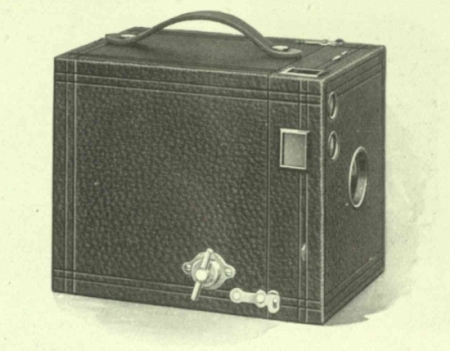
For those who want larger pictures, the No. 3 Brownie offers the same simplicity, the same reliability and the same proportionately low cost, in a camera for 3¼ × 4¼ pictures, as do the smaller Brownies.
This camera is capable of producing excellent pictures in the hands of the young or the old, and its negatives are of such quality as to yield very good enlargements by use of the inexpensive Brownie Enlarging Camera. In fact, this is a feature of all Brownies.
By the addition of a Kodak Portrait Attachment this instrument can be used with excellent success in home portraiture.
The No. 3 Brownie is well made in every respect. It has durable imitation leather covering, metal parts are nickeled and it offers the daylight-all-the-way feature of the Kodaks.
In Detail
For rectangular pictures, 3¼ × 4¼ inches. Capacity, 12 exposures without reloading. Size of camera, 6⅛ × 4⅜ × 5⅛ inches. Weight, 24 ounces. Lens, meniscus achromatic, 5-inch focus. Shutter, Eastman Rotary, with three stops. Two tripod sockets. Two finders.
The Price
| No. 3 Brownie Camera, meniscus achromatic lens, Eastman Rotary shutter | $4.00 | |
| No. 3 Brownie Carrying Case, with shoulder strap | 1.00 | |
| N. C. Film Cartridge, 12 exposures, 3¼ × 4¼ (No. 124) | .70 | |
| Ditto, 6 exposures | .35 | |
| Ditto, "double-two" cartridge, 4 exposures | .25 | |
| Kodak Portrait Attachment | .50 |

The folding Brownies are made upon the same idea of simplicity and low cost as the box forms. They are so closely related to the Kodaks—offering, as they do, the daylight-all-the-way feature and made in the Kodak factories, by Kodak workmen—that they well deserve the name "little cousins of the Kodaks."
The No. 2 is a very dainty little camera which will slip readily into an ordinary pocket, and make excellent pictures the all-by-daylight-way. It is fitted with our Pocket Automatic shutter working for time, bulb and snap-shot exposures, in which is mounted an excellent meniscus lens. Fitted with Kodak Portrait Attachment, this becomes a good camera for home portraiture, and the negatives which it makes will yield excellent 5 × 7 enlargements by use of the Brownie Enlarging Camera.
The camera is carefully finished throughout, it has imitation leather covering and nickeled fittings.
In Detail
For rectangular pictures, 2¼ × 3¼ inches. Capacity, 6 exposures without reloading. Size of camera, 6⅞ × 3⅝ × 2⅛ inches. Weight, 16 ounces. Lens, meniscus, 4½-inch focus. Shutter, Pocket Automatic. (See page 6.) Two tripod sockets. Automatic focusing lock. Reversible finder.
The Price
| No. 2 Folding Pocket Brownie, meniscus lens, Pocket Automatic shutter | $5.00 | |
| No. 2 Folding Pocket Brownie Carrying Case | .75 | |
| N. C. Film Cartridge, 6 exposures, 2¼ × 3¼ (No. 120) | .20 | |
| Kodak Portrait Attachment | .50 |

The pleasing proportions of the pictures taken by this little Brownie, combined with its simple operation and reliability, have made it one of the most popular cameras of the whole Brownie line.
For effective landscape composition and full and three-quarter length portraits, the shape of its pictures is ideal. And when fitted with Kodak Portrait Attachment, it may be operated close up to the subject for bust portraits.
Identical in construction and general design with the No. 2, this model can as easily be carried in the pocket, works for time, bulb and instantaneous exposures, and is well finished throughout. Attractively covered with best imitation leather, and metal parts are highly nickeled.
In Detail
For rectangular pictures, 2½ × 4¼ inches. Capacity, 12 exposures without reloading. Size of camera, 8½ × 2 × 3⅝ inches. Weight, 23 ounces. Lens, meniscus achromatic, 5-inch focus. Shutter, Pocket Automatic. Two tripod sockets. Automatic focusing lock. Reversible finder.
The Price
| No. 2A Folding Pocket Brownie, meniscus achromatic lens, Pocket Automatic shutter | $7.00 | |
| No. 2A Folding Pocket Brownie Carrying Case | .90 | |
| N. C. Film Cartridge, 12 exposures, 2½ × 4¼ inches (No. 116) | .50 | |
| Ditto, 6 exposures | .25 | |
| Kodak Portrait Attachment | .50 |

Always an efficient camera, the capabilities of the No. 3 Folding Brownie have been still further increased by the addition of the Brownie Ball Bearing shutter. This shutter, made upon the same principle as the Kodak Ball Bearing, with its star-shaped opening and smooth, accurate action, makes the camera especially effective for snap-shot work.
No. 3 Folding Brownies are well made, dependable cameras in every respect, they have the simplicity and daylight-all-the-way feature of their big cousins, the Kodaks, and offer the choice of either double or single lens equipment. Illustration shows camera with single lens.
In Detail
For rectangular pictures, 3¼ × 4¼ inches. Capacity, 12 exposures without reloading. Size of camera, 8⅜ × 4⅝ × 2⅝ inches. Weight, 25 ounces. Lens, meniscus achromatic, 5-inch focus. Shutter, Brownie Ball Bearing. (See page 7.) Automatic focusing lock. Two tripod sockets. Reversible finder.
The Price
| No. 3 Folding Brownie Camera, meniscus achromatic lens. Brownie Ball Bearing shutter | $ 9.00 | |
| Ditto, with R. R. lens and Brownie Ball Bearing shutter | 11.00 | |
| No. 3 Folding Brownie Carrying Case | 1.00 | |
| N. C. Film Cartridge, 12 exposures, 3¼ × 4¼ (No. 124) | .70 | |
| Ditto, 6 exposures | .35 | |
| Ditto, "double-two" cartridge, 4 exposures | .25 | |
| Kodak Portrait Attachment | .50 |
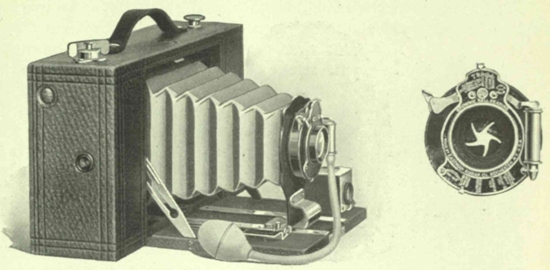
Like the No. 3, the efficiency of this model has been greatly augmented by addition of the Brownie Ball Bearing shutter.
It offers the choice of either single or double lens, and working with the usual Brownie simplicity, it makes a highly effective camera, for the popular 3¼ × 5½ pictures, at low cost.
This camera will produce extremely good results in general amateur photography, under ordinarily favorable conditions, and when fitted with Kodak Portrait Attachment, becomes a most dependable outfit for home portraiture. It is covered with durable imitation leather, has nickeled fittings and a neat, attractive appearance. Illustration shows camera with double lens.
In Detail
For rectangular pictures, 3¼ × 5½ inches. Capacity, 10 exposures without reloading. Size of camera, 2⅝ × 4⅝ × 9⅞ inches. Weight, 34 ounces. Lens, meniscus achromatic, 6½-inch focus. Shutter, Brownie Ball Bearing. (See page 7.) Automatic focusing lock. Two tripod sockets. Reversible finder.
The Price
| No. 3A Folding Brownie Camera, meniscus achromatic lens, Brownie Ball Bearing shutter | $10.00 | |
| Ditto, with R. R. lens and Brownie Ball Bearing shutter | 12.00 | |
| No. 3A Folding Brownie Carrying Case | 1.00 | |
| N. C. Film Cartridge, 10 exposures (No. 122) | .70 | |
| Ditto, 6 exposures | .40 | |
| Ditto, "double-two" cartridge, 4 exposures | .30 | |
| Kodak Portrait Attachment | .50 |
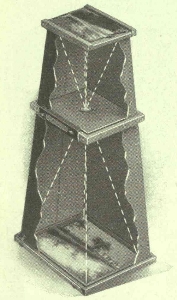
The average amateur usually thinks of enlarging as an intricate, expensive process, requiring considerable skill and experience. But such is not the fact. Even a youngster can make first-rate enlargements with a Brownie Enlarging Camera. It's just as easy as printing on Velox paper. In fact the two processes are very much the same, excepting that in printing, the negative and paper are in close contact, while in enlarging, the paper is at some distance from the negative, with a lens in between.
As shown in the illustration, the Brownie Enlarging Camera is simplicity itself. It's just a light-tight cone with an attachment at the small end to hold the negative, and another at the large end for the paper. Provision is made inside for holding the lens.
To make an enlargement, one merely places the negative and paper in place, holds the negative end up to the light for a specified time and then develops the paper as usual.
One of these inexpensive outfits will enable you to make enlargements at any time from your favorite negatives.
The cameras are collapsible, so that they fold flat and may be conveniently carried in a suit case.
The Price
| No. 2. Brownie Enlarging Camera, for 5 × 7 enlargements from 2¼ × 3¼ negatives | $2.00 | |
| No. 3. Ditto, for 6½ × 8½ enlargements from 3¼ × 4¼ negatives | 3.00 | |
| No. 4. Ditto, for 8 × 10 enlargements from 4 × 5 negatives (will also take 3¼ × 5½ negatives) | 4.00 |
This is made upon exactly the same principle as the Brownie Enlarging Camera, excepting that being small in itself, it is not made collapsible.
It offers the simplest means for making 3¼ × 5½ enlargements from 1⅝ × 2½ negatives.
The Price
| Vest Pocket Kodak Enlarging Camera | $1.75 |
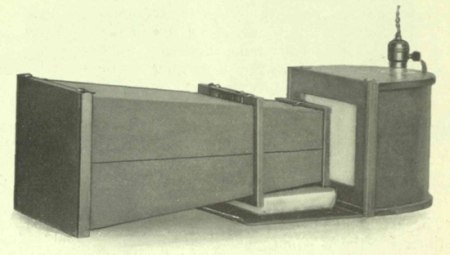
In enlarging with the Brownie or Vest Pocket Kodak Enlarging Camera, the exposure may be made by daylight, but to accommodate those who wish to do their enlarging at night or who prefer to use artificial light at all times we have devised the Brownie Enlarging Camera Illuminator, which assures the user a uniformly strong, even light, day or night. It is simply constructed, and moderate in price.
The illuminator is collapsible, but when set up, has the form of a half-round, light-proof box with socket through which is inserted an electric light bulb.
The inner walls of this box are white and act as a reflector when the light is turned on. At the end is a ground glass, which diffuses the light, so that by placing negative end of the enlarging camera in contact with this glass and turning on the electricity, an excellent steady printing light is obtained.
The glass is provided with a hinged protector of ruby cloth, which may be closed as soon as the exposure is completed, and the illuminator then becomes a perfect lamp for the developing and subsequent operations with the enlargement. Complete instructions for use are included with each outfit, and anyone who has electric light in the house will find it invaluable for enlarging purposes.
Brownie Enlarging Camera Illuminator, $3.50.
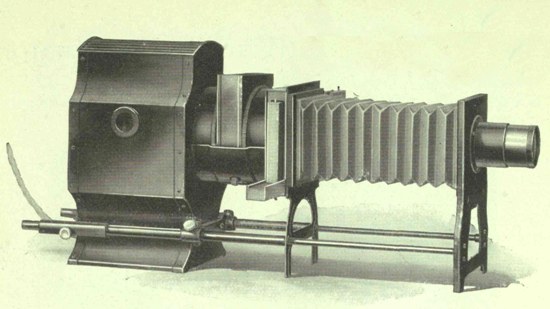
The Kodiopticon opens a new use—a new pleasure in his negatives, for the amateur photographer. For it enables anyone who has electricity in his house, to show sharp, well-illuminated lantern slide projections without difficulty and at small expense.
The Kodiopticon is substantially made, and operated with an ordinary Mazda electric lamp, at a distance of 10 feet from the sheet, will project images of about 36 inches. A larger image may be secured by setting the Kodiopticon a greater distance away, but the greater the distance the less the illumination. Can also be furnished with an electric arc lamp, when it can be used at 12 feet, with the maximum illumination, projecting an image of about 42 inches.
The Kodiopticon has a water jacket for protection of the slides from heat, and the price includes a strong wooden case, which, by reversing the top, serves as a permanent stand for the outfit.
The Price
| Kodiopticon, complete with Mazda Lamp | $25.00 | |
| Ditto, with Hand-feed Arc Lamp and 4 ampere Rheostat, accommodating 110 volts | 40.00 | |
| Ditto, accommodating 220 volts | 42.00 | |
| 100 Watt Mazda (Tungsten) Lamp, Concentrated Filament | 3.50 | |
| Eastman Portable Background Carrier | 3.00 | |
| Eastman Portable Background, plain, 4 × 5 feet | 1.50 | |
| Lantern Slide Plates, 3¼ × 4, per dozen | .45 | |
| Lantern Slide Cover Glass, per dozen | .20 | |
| Lantern Slide Binders, per package 50 strips | .10 | |
| Velox Lantern Slide Films, 2¾ × 3¼, per dozen | .30 | |
| Velox Lantern Slide Frames, per dozen | .25 | |
| Velox Lantern Slide Mats, 2⅞ × 35⁄16, per 2 dozen | .05 | |
| Nepera Solution, for developing Velox L. S. Films, 4-ounce bottle | .20 | |
| Lantern Slide Film Varnish, 4-ounce bottle | .25 |

An interesting and highly enjoyable diversion for the amateur photographer is the coloring of prints. And those who use the Kodiopticon will find that many slides are greatly improved by the addition of color. While actual color photography is by no means practical for general amateur use, anyone can make beautifully colored prints by the use of Velox Transparent Water Color Stamps.
No special artistic skill, no knowledge of painting whatever is necessary. Just a brush or two and the book of stamps, which includes simple directions for coloring both prints and lantern slides.
Each book includes twelve sheets of colors and each sheet is divided by perforations into twenty-two stamps. To use any color merely tear off a stamp, place in a small saucer or palette supplied with the outfit, and cover with about a teaspoonful of water.
The Velox Transparent Water Color Stamp Outfit offers the greatest convenience in coloring prints, as it includes the book of stamps, three brushes and a white enameled mixing palette, put up in a neat cardboard case.
| Velox Transparent Water Color Stamps, complete booklet, 12 colors | $0.25 | |
| Separate Color Leaves, two sheets | .05 | |
| Set of 3 Special Brushes, per set | .50 | |
| Mixing Palette | .25 | |
| Velox Transparent Water Color Stamp Outfit, including book, three brushes and palette | .75 |
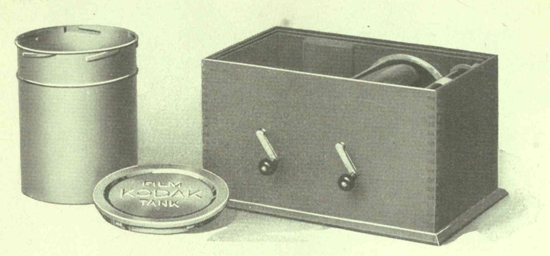
Development, that former bugbear of the amateur photographer and especially of the beginner, is made a simple proposition by the Kodak Film Tank—fully as simple as any part of the photographic process.
The Kodak Film Tank automatically develops every roll of film put into it, just as well as that roll of film could be developed by the most experienced photographer. If directions are followed, if the chemicals are mixed and the temperature regulated according to instructions, a boy or girl can get just as good results from the Kodak Film Tank as an expert by any method.
In other words, every roll of film put into the film tank, where the simple directions are implicitly followed, will come out developed as well, or better, than that roll of film could be developed in the dark room by the most experienced photographer. And it is very simple, it eliminates the dark room entirely, developing the film in broad daylight, and is so compact as to be easily carried and used anywhere.
The Kodak Film Tank consists of a winding box, a light-proof apron, and a heavily nickeled brass solution cup with cover. In the Brownie Film Tank, however, no cover is necessary as the film roll itself is turned. All articles can be packed in the box, making the entire outfit self-contained.
The film to be developed is placed upon a reel in the winding box, the cover is placed on the box and the film is wound around[Pg 43] an axis in combination with the apron, in such fashion that, when completely wound, the apron protects the film effectually from light, and may be removed from the winding box safely at any time. It is then lowered into the cup of developer, the cover attached and the film left to develop for twenty minutes. After development the film is removed for fixing.
Every step is performed in daylight and the exact time necessary for development, in combination with the chemical formula, has been scientifically worked out, so that all differences of exposure within reasonable bounds are taken care of. Especial attention is called to the new 2½-inch size, for the development of 1A or 2A films.
Those who wish to develop more than one roll at a time can do so without purchasing extra tanks complete, by securing duplicating outfits as listed below.
The Price
| Brownie Kodak Film Tank, for use with No. 1, No. 2 and No. 2 Folding Pocket Brownie Cartridges, complete | $2.50 | |
| Vest Pocket Kodak Film Tank, for Vest Pocket Cartridges, complete | 2.50 | |
| 2½-inch Kodak Film Tank, for use with all Kodak or Brownie cartridges having a film width of 2½ inches or less, complete | 3.50 | |
| 3½-inch Kodak Film Tank, for use with all Kodak and Brownie cartridges having a film width of 3½ inches or less, complete | 5.00 | |
| 5-inch Kodak Film Tank, for use with all Kodak and Brownie cartridges having a film width of 5 inches or less, complete | 6.00 | |
| 7-inch Kodak Film Tank, for use with No. 5 Cartridge Kodak or shorter film cartridges, complete | 7.50 | |
| Duplicating Outfit, consisting of one solution cup, one transferring reel, and one apron, for Brownie Kodak Film Tank | 1.25 | |
| Ditto, for Vest Pocket Film Tank | 1.25 | |
| Ditto, for 2½-inch Kodak Film Tank | 1.75 | |
| Ditto, for 3½-inch Kodak Film Tank | 2.50 | |
| Ditto, for 5-inch Kodak Film Tank | 3.00 | |
| Ditto, for 7-inch Kodak Film Tank | 3.75 | |
| Kodak Tank Developer Powders for Brownie Kodak Film Tank, per package, ½ dozen | .15 | |
| Ditto, for Vest Pocket Tank | .15 | |
| Ditto, for 2½-inch tank, per package, ½ dozen | .20 | |
| Ditto, for 3½-inch tank, per package, ½ dozen | .20 | |
| Ditto, for 5-inch tank, per package, ½ dozen | .25 | |
| Ditto, for 7-inch tank, per package, ½ dozen | .25 | |
| Kodak Acid Fixing Powder, per ¼-pound package | .10 | |
| Ditto, per ½-pound package | .15 | |
| Ditto, per 1-pound package | .25 |
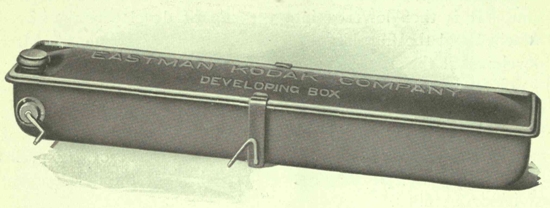
Offering the same assurance of perfectly developed film as the Kodak Film Tank, the Brownie Developing Box is a modified form of the same, so simple to use that any boy or girl can readily understand and operate it.
It consists of a metal box with cover, just long enough to accommodate a roll of No. 1 or No. 2 Brownie Film in one loop.
To develop, the roll of film is inserted in the spool carrier, and by means of a cord and winding shaft the film is unrolled and carried around a roller bearing, thus exposing the film to the action of the developer.
Before unrolling the film the developer is poured in the box and the cover put in place; all these operations being performed in daylight. The film is then unrolled by turning the crank, when the box is rocked on its standard for six minutes. The developer is then poured off and box filled with water to wash out developer, after which film is removed and fixed in daylight.
This is an excellent means, for those who have No. 1 or No. 2 Brownie Cameras, of developing their films without the need of skill or experience.
The Price
| No. 2 Brownie Developing Box | $1.00 | |
| Brownie Developing Box Powders, per package of 6 | .15 | |
| Kodak Acid Fixing Powders, ½-pound package | .15 | |
| Ditto, ¼-pound package | .10 |
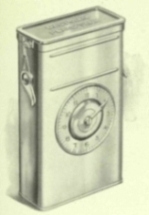
What the film tank has done for films, the plate tank does for plates. The idea of the two tanks is based upon the same time and temperature system of development, with, of course, such differences in actual construction of the tanks as are required by the physical differences between films and plates. And as plates must be unloaded in a dark room, the plate tank cannot offer the advantage of daylight quite all the way, but it takes only a few moments in the dark room to load this tank, after which it may be brought out into any light for development.
The device consists of a metal solution cup with cover, a cage for holding 12 or less plates, and a loading fixture for loading the plates in the cage.
The exposed plates are loaded into the cage and placed in the tank, which has been filled with developer, in the dark room and the tank cover fastened in place. On the front of the tank is a dial for registering time. Development is allowed to continue for fifteen minutes, the tank being reversed several times. After development the developer is washed out of the plates, and the fixing bath poured into the tank, after which the plates are ready for washing in the usual manner.
The Price
| Eastman Plate Tank, for 4 × 5, 3¼ × 5½, and smaller plates, includes solution cup, plate cage, loading fixture and adjustable kit | $3.50 | |
| Ditto, 5 × 7, without kit | 4.50 | |
| Adjustable Kit, for 4 × 5 or 3¼ × 5½ tank, to take smaller plates | .50 | |
| Separate Kits, for 5 × 7 tank, to take 3¼ × 5½, 4¼ × 6½ or 4¾ × 6½ plates, each | .75 | |
| Metal Insert, for 5 × 7 tank, to take 4 × 5 plates | .10 | |
| Eastman Plate Tank Developer Powders, for 4 × 5 tank, per package, ½ dozen | .20 | |
| Ditto, for 5 × 7 tank, per package, ½ dozen | .35 | |
| Kodak Acid Fixing Powder, per 1 pound package | .25 | |
| Ditto, per ½-pound package | .15 |
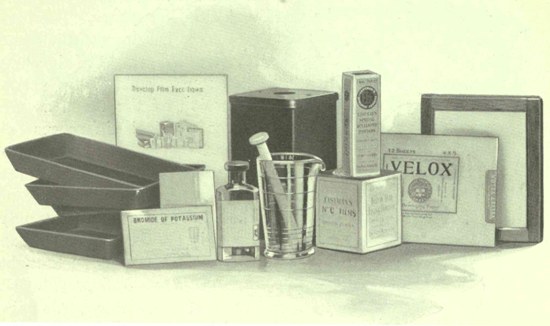
The Eastman 3A Outfit contains every requisite for finishing twenty-four 3¼ × 5½ or smaller pictures, and by combining a variety of different articles and making up the outfits in large quantities, we furnish them at a much lower price than if the articles were purchased separately.
| One Kodak Candle Lamp | $0.25 | |
| One Printing Frame | .25 | |
| One Glass for Frame | .05 | |
| One 4-ounce Graduate | .10 | |
| One Stirring Rod | .05 | |
| Four Developing Trays | .40 | |
| Five tubes Eastman Special Developer | .25 | |
| One half pound Kodak Acid Fixing Powder | .15 | |
| One Package Potassium Bromide | .05 | |
| Two dozen 3¼ × 5½ Velox Paper | .30 | |
| Three Eastman Metol Quinol Powders, for developing Velox | .15 | |
| Instruction Book | .10 | |
| $2.10 |
Eastman 3A Outfit, complete, neatly packed, $1.50.
| EASTMAN A B C OUTFIT, similar to above but providing for 4 × 5 or smaller pictures | $1.50 | |
| BROWNIE Developing and Printing Outfit, complete, for developing and printing 24 pictures 2¼ × 2¼. Price, complete | .90 |
Note—These outfits cannot be shipped by mail.
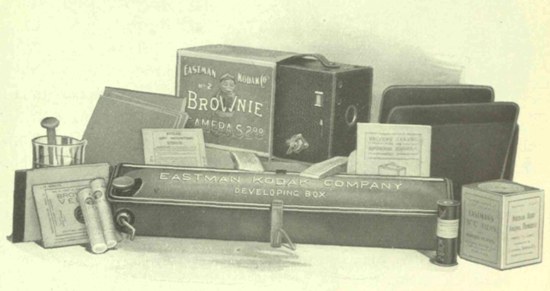
The Kodak box No. 2 contains everything for picture making by the daylight method. No dark room is necessary, and even the beginner can get good results by following the simple, explicit directions contained in the instruction book. This outfit is simple enough for boys and girls, while at the same time it will make pictures which will please the grown-up people.
The Price
| One No. 2 Brownie Camera, 2¼ × 3¼ | $2.00 | |
| One No. 2 Brownie Developing Box | 1.00 | |
| One Roll No. 2 Brownie Film, 2¼ × 3¼ | .20 | |
| Two Brownie Developing Box Powders | .05 | |
| One ½-pound package Kodak Acid Fixing Powder | .15 | |
| One 4-ounce Graduate | .10 | |
| One Stirring Rod | .05 | |
| One No. 2 Brownie Printing Frame | .15 | |
| One Package (1 dozen) 2¼ × 3¼ Brownie Velox | .10 | |
| Two Eastman Metol Quinol Developer Powders | .10 | |
| Three Paper Developing Trays | .30 | |
| One Dozen 2¼ × 3¼ Mounts | .10 | |
| One Dozen 2¼ × 3¼ Kodak Dry Mounting Tissue | .05 | |
| One Instruction Book | .10 | |
| $4.45 |
Price, complete, neatly packed, $4.00.
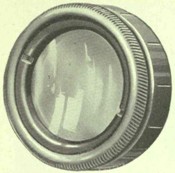
There is no greater pleasure in photography than Home Portraiture, and this little attachment, fitted to a Kodak or Brownie Camera, will enable one to work up close to the subject and thereby secure bust portraits of excellent quality limited in size, with the focusing Kodaks, only by the dimensions of the film. The attachments are simply extra lenses, which slip on in front of the regular lens, and they in no way affect the operation of the instrument, excepting to make the lens cut sharp at short distances.
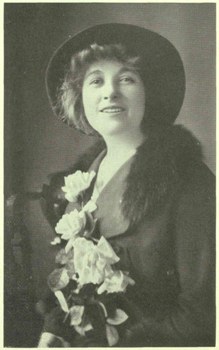
These attachments are not only serviceable for portraiture but also for photographing any small object, such as flowers, fruits, still life composition, at close range. Please order by number, or if required for older models or cameras with special equipments specify shutter and size of camera.
The Price
| No. 1. For No. 2 Brownie, No. 2 and No. 2A F. P. Brownie, Vest Pocket and No. 1 and No. 1A F. P. K. | $0.50 | |
| No. 2. For No. 2A Brownie | .50 | |
| No. 3. For No. 1A Kodak Junior, both single and double lens; No. 1A F. P. K., R. R. Type; No. 3 F. P. K., No. 3 Folding Brownie | .50 | |
| No. 4. For No. 2 and No. 3 Bull's-Eye, No. 3 Brownie | .50 | |
| No. 5. For Nos. 3A, 4 and 4A Folding Kodaks and No. 3A Folding Brownie | .50 | |
| No. 6. For No. 3 Special and Six-Three and 1A Special and Six-Three Kodaks | .50 | |
| No. 7. For No. 3A Special and Six-Three Kodaks | .50 | |
| No. 8. For No. 1 Kodak Junior, both single and double lens, and Vest Pocket Kodak Special | .50 | |
| No. 9. For No. 3 F. P. K. with Kodak Automatic shutter | .50 | |
| No. 10. For No. 1 Brownie | .50 |
These screens are of great value in outdoor photography, and for all subjects embracing colors which act weakly on the sensitive film, as they hold back the strong blue and violet rays, affording the weaker colors time to record. The Kodak Color Screens are mounted in the same manner as the Kodak Portrait Attachment.
The Price
| No. 1. For Vest Pocket, Nos. 1 and 1A Folding Pocket Kodaks, Nos. 2 and 2A Folding Pocket Brownies | $0.50 | |
| No. 2. For No. 2A Brownie | .50 | |
| No. 3. For No. 1A Kodak Junior, both single and double lens; Nos. 2 and 3 Folding Pocket Kodaks; No. 1A F. P. Kodak, R. R. Type; and No. 3 Folding Brownie | .75 | |
| No. 4. For Nos. 2 and 3 Bull's-Eye and No. 3 Brownie | .75 | |
| No. 5. For Nos. 3A, 4 and 4 A Kodaks. No. 3A Folding Brownie | 1.00 | |
| No. 6. For Nos. 1A Special and Six-Three Kodaks and 3 Special and Six-Three Kodaks | .75 | |
| No. 7. For No. 3A Special and Six-Three Kodaks | 1.00 | |
| No. 8. For No. 1 Kodak Junior, both single and double lens, and Vest Pocket Kodak Special | .50 | |
| No. 9. For No. 3 F. P. K. with Kodak Automatic shutter | .50 |
These lenses have a speed of f. 16 and are interchangeable with the lenses furnished with the Nos. 3A and 4 Folding Pocket Kodaks, and the No. 4A Folding Kodak. With each one we furnish a leather case and a graduated focusing scale for the camera bed.
In ordering a Kodak wide angle lens, give size (No.) of Kodak and be sure to specify the shutter that the lens is to be used with.
The Price
| No. 4. (4 × 5) Kodak Wide Angle Lens, equivalent focus, 4 ½ inches | $5.00 | |
| (Also adapted to 3A Kodak.) | ||
| No. 5. (5 × 7) Kodak Wide Angle Lens, equivalent focus, 5 ½ inches | 7.50 | |
| (Also adapted to 4A Kodak.) |
Metal Tripods

These tripods have the qualities that make for service as well as good appearance.
Light and very compact, they are yet rigid when extended because of their special construction. The principle is that of a telescope, each section sliding into the one above it, till the whole length is reduced to a single section and the sections are securely fastened to one another.
Nos. 380, 390, 400 and 410 fold up flat, the first three being supplied in neat cases. Nos. 400 and 410 have the additional advantage of being fitted with a patent top, which provides a broad firm table for supporting the camera, but folds to the side when tripod is not in use. Upper or outer sections are all black enameled, lower section brass.
| No. 320. 5 sections, length closed 14½ inches | $3.00 | |
| No. 330. 7 sections, length closed 11¾ inches | 3.75 | |
| No. 340. 4 sections, length closed 15½ inches | 2.50 | |
| No. 380. 7 sections, length closed 11¾ inches | 6.25 | |
| No. 390. 7 sections, length closed 11½ inches | 5.00 | |
| No. 400. 7 sections, length closed 12 inches | 6.50 | |
| No. 410. 4 sections, length closed 16 inches | 3.25 |
Adjustable Heads (extra) fitted with ball and socket joint, suitable for any of above Tripods.
| No. 300 | $1.00 | |
| No. 305 | $1.50 | |
| No. 310 | $1.75 |
The Eastman

Three sections. No. 1, maple, for cameras up to 6½ × 8½.
Price, $2.25.
The Bull's-Eye

Two sections. Aluminum revolving head. Made of maple, with brass fittings. For 4 × 5 cameras, or smaller. Length, extended, 42½ inches; folded 24 inches. The only two-section tripod that will go in a suitcase.
Price, $1.50.
The Standard

The feature of this tripod is the automatic locking of the sections when they are extended. Light, compact and rigid. Fixed, non-detachable head. Length, folded. 21 inches; extended, 53½ inches. Weight, 18 ounces. Cherry finish, brass trimmings.
Price, $1.75.
The Flexo

Two sections. Fixed, non-detachable head. Only clear, straight-grained wood is used in its construction.
Price, $1.00.

Folding Pocket Kodak Tripod Adapter No. 1.
A simple and effective device for holding either the No. 1 or No. 1A Folding Pocket Kodak on a tripod in either horizontal or vertical position. Kodak may be reversed without removing from the adapter.
| F. P. K. Tripod Adapter No. 1 | $0.75 |
Velox is the very best paper for amateur use for it is simple to use, thoroughly dependable and is made in a variety of grades and surfaces to fit all sorts of amateur negatives.
It prints in any light, requires no dark room and permits the amateur to utilize his evening hours in print making. Its simplicity of manipulation and extreme gradation make it suitable for photographic work of every kind.
Velox is divided broadly into two kinds of paper called "Regular" and "Special" (hard and soft) each division containing a variety of surfaces. "Regular" papers develop quickly and are best suited for negatives lacking contrast. "Special" papers develop slowly, and give soft effects from hard negatives. Use "Special" Velox for negatives producing good results on "Printing Out" paper (such as Solio), and "Regular" only with very flat negatives (negatives lacking contrast).
Velox surfaces: In the "Regular" class are carbon (matte surface), Glossy, Glossy double weight, Velvet, and Velvet double weight. "Regular" Velvet Velox is semi-gloss and gives prints of exceptional beauty. This paper will give satisfactory results from very flat negatives.
In the "Special" class, the surfaces are Carbon (matte surface), Portrait (smooth matte), Portrait double weight, Rough, Glossy, Glossy double weight, Velvet, and Velvet double weight.
"Special" Velvet Velox has a greater range than any of the other "Special" papers.
Royal Velox is coated on a soft, mellow-tinted stock, which when re-developed affords all the soft delicacy of a rare old etching. It is made in two grades, "Regular" and "Special" and one surface, just rough enough to produce the desired effect.
The Price
| Size | Single Weight | Double Weight | ||||
| Dozen | ½ Gross | Gross | Dozen | ½ Gross | Gross | |
| 1⅝ × 2½ | $0.15 | $0.60 | $1.00 | $0.20 | $0.75 | $1.25 |
| 2¼ × 3¼ | .15 | .60 | 1.00 | .20 | .75 | 1.25 |
| 2½ × 4¼ | .15 | .70 | 1.25 | .20 | .90 | 1.55 |
| 3½ × 3½ | .15 | .80 | 1.50 | .20 | 1.00 | 1.90 |
| 3¼ × 4¼ | .15 | .80 | 1.50 | .20 | 1.00 | 1.90 |
| 3¼ × 5½ | .15 | .80 | 1.50 | .20 | 1.00 | 1.90 |
| 4 × 5 | .25 | 1.10 | 2.00 | .30 | 1.40 | 2.50 |
| *3¼ × 6(Stereo) | .25 | 1.10 | 2.00 | |||
| **3⅜ × 6½ | .25 | 1.10 | 2.00 | |||
| 2¼ × 7 | .15 | .80 | 1.50 | .20 | 1.00 | 1.90 |
| 4½ × 6½ | .30 | 1.65 | 2.80 | .40 | 2.05 | 3.50 |
| 5 × 7 | .35 | 2.00 | 3.50 | .45 | 2.50 | 4.40 |
| 3½ × 12 | .45 | 2.50 | 4.50 | .55 | 3.15 | 5.65 |
| Velox Post-cards, 3½ × 5½, furnished in Regular Velvet, Special Velvet, Special Portrait, Regular Glossy, Special Glossy and Regular Royal and Special Royal |
.20 | 1.10 | 2.00 | |||
| Ditto, Double Post-cards, 3½ × 11 inches | .40 | 2.20 | 4.00 | |||
| Brownie Post-cards, 2¾ × 4¼, Regular and Special Velvet | .15 | .80 | 1.50 | |||
* Glossy only
** For use in Self-transposing Stereo Printing Frame.
Brownie Velox (one grade only)
| 2¼ × 2¼, per package 2 dozen sheets | $0.15 | |
| 2¼ × 3¼, per package 1 dozen sheets | .10 |
Velox Sundries
| N. A. (Non-abrasion) Velox Liquid Developer, 4-ounce bottle (makes 20 ounces for Special, 12 ounces for Regular) | $0.25 | |
| Ditto, 16-ounce bottle | .75 | |
| Nepera Solution, per 4-ounce bottle | .20 | |
| Ditto, per 16-ounce bottle | .60 | |
| Nepera Capsules (for converting Nepera solution to a film or plate developer), per package 1 dozen | .15 | |
| Velox Re-developer for Sepia Tones, per 4-ounce bottle | .50 | |
| Ditto, 2 ounces (sufficient for 150 4 × 5 prints) | .30 | |
| Velox Re-developer Tubes, per package 12 tubes | .60 | |
| Velox Liquid Hardener, per 4-ounce bottle | .15 | |
| Ditto, 8-ounce bottle | .25 | |
| Kodak N. A. M. Q. Developer, per package 3 tubes | .25 | |
| Kodak Acid Fixing Powder for fixing Velox prints, per pound | .25 | |
| Ditto, ½ pound | .15 | |
| Ditto, ¼ pound | .10 |
Effects heretofore to be had only by the laborious carbon process can now be secured by any amateur photographer with this new paper.
For landscapes, for marines, and in fact, for the majority of outdoor amateur negatives, the rich green of prints on Kodak Velvet Green produces most beautiful harmonious effects, with an indescribable "atmosphere" of nature itself.
And to use this paper the amateur has to learn no new processes nor possess extraordinary skill. Anyone who can print on Velox paper can print just as successfully on Kodak Velvet Green, as the two processes after exposure are identical, and the developing solution is only slightly changed.
The surface—a smooth semi-matte—brings out detail fully, and the paper is supplied in both single and double weights.
Kodak Velvet Green Post-cards are very appropriate for use at vacation time.
Prices same as for Velox. (See page 53.)
Angelo Platinum Paper is exceedingly simple to handle and yields prints that are marvelous in gradation and delicacy. Made in Sepia only.
Angelo Sepia, unlike most Sepia Platinum Papers, develops in a cold solution.
| Size | Price per Doz. | Size | Price per Doz. | ||
| 3½ × 3½ | $0.25 | 3¼ × 5½ | $0.40 | ||
| 3¼ × 4¼ | .25 | 4¼ × 6½ | .55 | ||
| 4 × 5 | .40 | 5 × 7 | .65 |
ANGELO SOLUTION
| Angelo Sepia Solution (2-ounce bottle) | $0.30 | |
| Angelo Sepia Salts (2-ounce package) | 0.10 |
Rich sepia and purple tones. Print, wash and fix.
| Aristo Gold Post-cards, per dozen | $0.30 |
A rapid, glossy printing-out paper.
| Size | Per Package 2 Doz. | |
| 2½ | × 2½ | $0.20 |
| 2¼ | × 3¼ | .20 |
| 2½ | × 4¼ | .20 |
| 3½ | × 3½ | .20 |
| 3¼ | × 4¼ | .20 |
| 3¼ | × 5½ | .25 |
| 4 | × 5 | .25 |
| 3¼ | × 6 (Stereo) | .25 |
| 2½ | × 7 (No. 1 Panoram Kodak) | .25 |
| Per Doz. | ||
| 4¼ | × 6½ | $0.25 |
| 5 | × 7 | .30 |
| 3½ | × 12 (No. 4 Panoram Kodak) | .35 |
| Post-cards | .15 | |
| Double Solio Post-cards | .30 | |
| Brownie Post-cards, 2¾ × 4¼ | .10 | |
Solio Combined Toning and Fixing Solution, per 8-ounce bottle, 50 cents. Ditto, 4-ounce bottle, 30 cents; post-paid, 50 cents. Solio Toning and Fixing Powders, per box of 5 tubes, 25 cents.
A "Blue Print" that retains delicacy and detail.
| 1 Doz. | ||
| Post-cards (in sealed tubes) | $ 0.15 |
For enlargements. Grades: Velvet, Royal, Standard, Platino, Enameled and Matte-enamel.
| Size | per. Doz. | ||
| 5 | × 7 | $0.35 | |
| 5 | × 8 | .40 | |
| 6½ | × 8½ | .60 | |
| 8 | × 10 | .80 | |
| 10 | × 12 | 1.20 | |
| 11 | × 14 | 1.60 | |
| 14 | × 17 | 2.40 | |
| 16 | × 20 | 3.20 | |
| 18 | × 22 | 4.00 | |
Other sizes in proportion
Every side of Amateur Photography is treated in this little book. The Lens, the Camera, Composition, Exposure, Developing and Printing are all handled in a most helpful and simple manner. Flash Light and High Speed work are described in detail. The text is made plainer by numerous illustrations and even a child can understand clearly what is meant, for technical terms are avoided or made perfectly plain.
The Price
| "How to Make Good Pictures," paper cover | $ 0.25 | |
| Ditto, library edition, cloth bound | 1.00 |
The Kodak Album
Made on a new principle, which does away with mounting prints by paste or otherwise. They are merely slipped into pocket strips at top and bottom, and will not come out unless removed by hand. Handsome grain leather cover and black leaves with linen finish.
| A, 2¼ × 3¼, | 25 leaves, 3 on | $2.75 | |
| B, 2½ × 4¼, | 25 leaves, 3 on | 3.00 | |
| C, 3¼ × 4¼, | 25 leaves, 3 on | 3.00 | |
| D, 3¼ × 5½, | 25 leaves, 3 on | 3.25 | |
| E, 3¼ × 5½, | 50 leaves, 3 on | 4.25 | |
| F, 4 × 5, | 25 leaves, 2 on | 3.00 | |
| G, 4¼ × 6½, | 25 leaves, 2 on | 3.25 | |
| H, 5 × 7, | 25 leaves, 2 on | 3.50 |
The Interchange Album
An unusually long-lived album on the loose leaf principle. Has special embossed leather cover with grain leather corners and back. Furnished with 50 linen finish leaves—black only.
| Pkg. 12 ex. le'v's | Pkg. 12 ex. le'v's | ||||||
| A, 5 × 8 | $3.00 | $0.15 | C, 10 × 12 | $5.00 | $0.30 | ||
| B, 7 × 11 | 3.50 | .20 | D, 11 × 14 | 6.00 | .40 |
The Agrippa Album
A new, unusually flexible loose leaf album with beautiful grain leather covering and 50 linen finish black leaves.
| Pkg. 12 ex. le'v's | Pkg. 12 ex. le'v's | ||||||
| A, 5 × 8 | $1.60 | $0.15 | C, 10 × 12 | $3.50 | $0.30 | ||
| B, 7 × 11 | 1.90 | .20 | D, 11 × 14 | 3.75 | .40 |
The Arena Album
Flexible, finest quality black grain leather cover.
| J, 50 Black leaves, or S, 50 Sepia leaves, 5½ × 7 | $1.25 | |
| K, 50 Black leaves, or T, 50 Sepia leaves, 7 × 10 | 1.90 | |
| L, 50 Black leaves, or U, 50 Sepia leaves, 10 × 7 | 1.90 | |
| M, 50 Black leaves, or W, 50 Sepia leaves, 11 × 14 | 3.75 |
The Tiber Album
A very flexible loose leaf album with imitation leather covering and 50 black leaves.
| Pkg. 12 ex. le'v's | Pkg. 12 ex. le'v's | ||||||
| A, 5 × 8 | $0.80 | $0.15 | C, 10 × 12 | $1.90 | $0.30 | ||
| B, 7 × 11 | 1.15 | .20 | D, 11 × 14 | 2.20 | .40 |
The Forum Album
Flexible, black imitation leather embossed cover.
| A, 25 Black leaves, or N, 25 Sepia leaves, 5½ × 7 | $0.45 | |
| B, 25 Black leaves, or O, 25 Sepia leaves, 7 × 10 | .60 | |
| C, 25 Black leaves, or P, 25 Sepia leaves, 10 × 7 | .60 | |
| D, 25 Black leaves, or R, 25 Sepia leaves, 11 × 14 | 1.60 | |
| E, 50 Black leaves, 5½ × 7 | .60 | |
| F, 50 Black leaves, 7 × 10 | .95 | |
| G, 50 Black leaves, 10 × 7 | .95 | |
| H, 50 Black leaves, 11 × 14 | 1.90 |
Artist's Album
Loose leaf system, silk lacing.
| No. 1, Black leaves; No. 2, White leaves; No. 3, Sepia leaves, 5½ × 7 | $0.25 | |
| Extra leaves, package of 5 | .09 | |
| No. 4, Black leaves; No. 5, White leaves; No. 6, Sepia leaves, 7 × 10 | .35 | |
| Extra leaves, package of 5 | .12 |
Snap-shot Album
Substantial card covering, soft black leaves.
| No. 19 20 pages, 5½ × 7 | $0.12 | No. 18 20 pages, 7 × 10 | $0.15 |
Souvenir Post-card Album
Flexible, black leather embossed cloth cover.
| X, | 25 Black leaves, 10 × 7, for 100 cards | $0.60 | |
| X, R, | 25 Black leaves, 11 × 14, for 200 cards | 1.90 | |
| X, T, | Flexible, Black grain leather cover 25 leaves, 11 × 14, for 200 cards | 3.20 |
Woodmat
A new medium for mounting prints on the "slip in" principle, giving the effect of a rich brown wood frame.
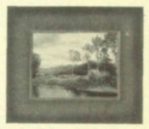
| For Print | Outside | Each | ||||
| No. 1 | 2¼ × 3¼ | 4⅜ × 5⅜ | $0.06 | |||
| No. 1A | 2½ × 4¼ | 4⅝ × 6⅜ | .07 | |||
| No. 3 | 3¼ × 4¼ | 5½ × 6½ | .08 | |||
| No. 3A | 3¼ × 5½ | 6¼ × 8⅜ | .09 | |||
| No. 4 | 4 × 5 | 6¾ × 7¾ | .09 |
Eastman Film Negative Albums

| For 100 negatives, 2½ × 4¼, or smaller | $ .75 | |
| For 100 negatives, 3½ × 3½ or smaller | .75 | |
| For 100 negatives, 3¼ × 4¼, or 4 × 5 | 1.00 | |
| For 100 negatives, 3¼ × 5½, or smaller | 1.00 | |
| For 100 negatives, 5 × 7, or smaller | 1.50 |
Kodak Mounts
VIEW
Carbon Black, and Scotch Grey, felt surface, bevelled edges, no embossed design
| For Prints | Size Outside | Per 50 | Per doz. | |||||
| 1⅝ | × 2½ | 3¼ | × 4 | $0.30 | $0.10 | |||
| 2¼ | × 3¼ | 4 | × 5 | .35 | .10 | |||
| 2¼ | × 4¼ | 4¼ | × 6 | .45 | .15 | |||
| 3½ | × 3½ | 5 | × 5 | .45 | .15 | |||
| 3¼ | × 4¼ | 5 | × 6 | .55 | .20 | |||
| 3¼ | × 5½ | 5¼ | × 7½ | .65 | .20 | |||
| 4 | × 5 | 5⅜ | × 6⅜ | .60 | .20 | |||
| 2¼ | × 7 | 4 | × 8¾ | .60 | .20 | |||
| 4¼ | × 6½ | 6¼ | × 8½ | .85 | .25 | |||
| 5 | × 7 | 7 | × 9 | .95 | .30 | |||
| 3½ | × 12 | 5⅜ | × 13¾ | 1.10 | .30 | |||
LAGOON
Jet Black, Ash Grey and White
| For Prints | Size Outside | Per 50 | Per doz. | |||||
| 2¼ | × 2¼ | 3⅝ | × 3⅝ | $0.40 | $0.10 | |||
| 2¼ | × 3¼ | 4 | × 5 | .45 | .15 | |||
| 2½ | × 4¼ | 4¼ | × 6 | .55 | .15 | |||
| 3½ | × 3½ | 5 | × 5 | .55 | .15 | |||
| 3¼ | × 4¼ | 5 | × 6 | .65 | .20 | |||
| 3¼ | × 5½ | 5¼ | × 7½ | .75 | .25 | |||
| 4 | × 5 | 5⅜ | × 6⅜ | .70 | .20 | |||
| 4¼ | × 6½ | 6¼ | × 8½ | 1.05 | .30 | |||
| 5 | × 7 | 7 | × 9 | 1.15 | .35 | |||
RIVERVIEW
A Slip-in Mount, no paste needed. Grey and Brown—Oval and Square
| For Prints | Size Outside | Per 50 | Per doz. | |||||
| 2¼ | × 3¼ | 4 | × 5 | $0.75 | $0.25 | |||
| 2½ | × 4¼ | 4⅛ | × 5⅞ | .85 | .30 | |||
| 3½ | × 3½ | 5 | × 5 | .90 | .30 | |||
| 3¼ | × 4¼ | 5 | × 6 | .95 | .30 | |||
| 3¼ | × 5½ | 5 | × 7 | 1.00 | .35 | |||
| 4 | × 5 | 5¾ | × 6¾ | 1.05 | .35 | |||
GLENCAIRN
Slip-in Style, Solid Back, Grey and Buff, Square only
| For Prints | Size Outside | Per 50 | Per doz. | |||||
| 2¼ | × 3¼ | 4 | × 5 | $1.05 | $0.30 | |||
| 2½ | × 4¼ | 4¼ | × 6 | 1.15 | .35 | |||
| 3¼ | × 4¼ | 5 | × 6 | 1.25 | .40 | |||
| 3¼ | × 5½ | 5¼ | × 7½ | 1.45 | .45 | |||
| 4 | × 5 | 5⅞ | × 6⅞ | 1.55 | .50 | |||
RIVERA
Jet Black, White and Artists Brown, wide border, bevelled edges
| For Prints | Size Outside | Per 50 | Per doz. | |||||
| 2¼ | × 3¼ | 4½ | × 5⅜ | $0.60 | $0.20 | |||
| 2½ | × 4¼ | 5 | × 6¾ | .70 | .20 | |||
| 3½ | × 3½ | 5⅜ | × 5⅜ | .65 | .20 | |||
| 3¼ | × 4¼ | 5⅜ | × 6⅜ | .75 | .25 | |||
| 3¼ | × 5½ | 5¾ | × 8 | 1.00 | .30 | |||
| 4 | × 5 | 6½ | × 7⅜ | 1.05 | .30 | |||
| 4¼ | × 6½ | 6¾ | × 8¾ | 1.15 | .35 | |||
| 5 | × 7 | 7¼ | × 9¼ | 1.20 | .35 | |||
RIDGEWAY
In duplex form, for Oval or Square Prints, Brown and Grey.
| For Prints | Size Outside | Per 50 | Per doz. | |||||
| 2¼ | × 3¼ | 4 | × 5 | $1.05 | $0.30 | |||
| 2½ | × 4¼ | 4¼ | × 6 | 1.15 | .35 | |||
| 3¼ | × 4¼ | 5 | × 6 | 1.25 | .40 | |||
| 3¼ | × 5½ | 5¼ | × 7½ | 1.45 | .45 | |||
| 4 | × 5 | 5⅞ | × 6⅞ | 1.55 | .50 | |||
Stereo Mounts
Size of mount, 3½ × 7; color, English Grey; per 100, $0.65; per 50, $0.35
Kodak Dry Mounting Tissue
Mounts prints even on thin mounts without curl. The simplest method of mounting, no apparatus being required—just fix the tissue on print, lay on mount and press with a warm flat iron; no sticky fingers, no muss of any kind.
The Price
| Size, 3½ × 3½, 3 dozen | $0.10 | |
| Size, 3¼ × 4¼, 3 dozen | .10 | |
| Size, 3¼ × 5½, 2 dozen | .10 | |
| Size, 4 × 5, 2 dozen | .10 | |
| Size, 4¼ × 6½, 1 dozen | .10 | |
| Size, 5 × 7, 1 dozen | .10 |
Glass Dry Plates
Seed and Royal Special Extra Rapid.
| Size | Per doz. | |
| 3½ × 3½ | $0.35 | |
| 3¼ × 4¼ | .45 | |
| 3¼ × 5½ | .65 | |
| Royal Lantern Slide Plates, 3¼ × 3¼ | .35 | |
| Ditto, 3¼ × 4 | .45 | |
| 4 × 5 | .65 | |
| 4¼ × 6½ | .90 | |
| 5 × 7 | 1.10 | |
| Cover Glass, 3¼ × 3¼ | .18 | |
| Ditto, 3¼ × 4 | .20 | |
| Lantern Slide Binders, per package, 50 strips | .10 |
Printing Frames
| Eastman 3½ × 3½, opens two-thirds | $0.25 | |
| Eastman 3¼ × 4¼, opens two-thirds | .25 | |
| Eastman 3¼ × 5½, for films, opens two-thirds | .25 | |
| Ditto, for plates | .25 | |
| Eastman 4 × 5, opens two-thirds | .25 | |
| Eastman 5 × 7, opens two-thirds | .35 | |
| Eastman 3½ × 12, for No. 4 Panoram Kodak, opens in three sections | .75 | |
| Eastman 2¼ × 7, for No. 1 Panoram Kodak, opens in two sections | .30 | |
| Brownie Printing Frame, No. 1, for 2¼ × 2¼ Developing paper only | .10 | |
| Brownie Printing Frame, No. 2, for 2¼ × 3¼ Developing paper only | .15 |
Developing Trays
| "Bull's-Eye" Composition, 4 × 6 | $0.15 | |
| "Bull's-Eye" Composition, 5 × 7 | .30 | |
| "Bull's-Eye" Composition. 3 × 8½ | .22 | |
| "Bull's-Eye" Composition, 4½ × 14 | .50 | |
| Maple Leaf Enameled, 4 × 5 | .20 | |
| Maple Leaf Enameled, 4 × 6 | .25 | |
| Maple Leaf Enameled, 5 × 7 | .35 |

The simplest and safest method of making flash-light pictures is by means of the Eastman Flash Sheets and Kodak Flash Sheet Holder. The sheets burn slowly, giving a broad, soft light, and not so startling the subject as to give a staring effect to the eyes.
The holder is a genuine innovation. A saw tooth holds the sheet in proper position and it is lighted from the back through an aperture provided in the centre for the purpose. In this manner the holder is always between the operator and the flash sheet, and it may be held in the hand or supported on a tripod, a socket being provided for the latter purpose.
| No. 1 Flash Sheets, per package of ½ dozen sheets, 3 × 4 | $0.25 | |
| No. 2 Flash Sheets, per package of ½ dozen sheets, 4 × 5 | .40 | |
| No. 3 Flash Sheets, per package of ½ dozen sheets, 5 × 7 | .60 | |
| Kodak Flash Sheet Holder | 1.00 |
Kodak Magnesium Ribbon Holder
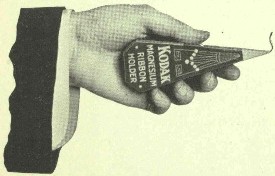
This extremely handy little apparatus provides a most convenient method of burning magnesium ribbon for photographic purposes. It comprises at once a compact magazine for storing the ribbon, a convenient holder for burning it, and a ready means of measuring definite lengths.
For printing on Velox and other gas light papers, lantern slides, etc., the ribbon is pushed forward by a movement of the thumb upon the edge of the revolving disc until the desired length of ribbon projects from holder.
| Kodak Magnesium Ribbon Holder | $0.20 | |
| Alcohol Lamp for use with above | .25 |
Flashlight Material cannot be sent by mail.
Kodak Trimming Boards
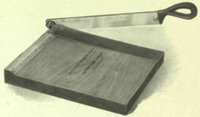
Made of hard wood, with natural finish, have fine quality steel blades and are fitted with rule.
| No. 1, capacity, 5 × 5 inches | $0.40 | |
| No. 2, capacity, 7 × 7 inches | .60 | |
| Transparent Trimming Gauge (extra) | .20 |
Kodak Candle Lamp

This clever little lamp is collapsible and can be packed into very small space when not in use. It is made of special tested ruby fabric, bound in metal frames and gives a strong, safe light for the dark room.
| Kodak Candle Lamp | $0.25 | |
| Extra Candles for same, per dozen | .30 |
Kodak Dark Room Lamp

The Kodak Dark Room Lamp is oil burning and is fitted with both orange and ruby glass. It has an unusually broad wick regulated from the outside and gives a soft, steady light for the dark room.
| No. 2 Kodak Dark Room Lamp | $1.00 |
Velox Lantern Slide Film
For use with the Kodiopticon or any other lantern slide projector that has a water cell cooling device. With these films you can make lantern slides by contact as easily as you can make Velox prints, the exposure, development and printing being the same. For making slides by projection they are as convenient as any plate.
After the slide is made, it is masked with Velox Lantern Slide Mats and mounted in the Velox Lantern Slide Frame which has standard opening, and eliminates the binding of the edges.
These slides are absolutely unbreakable.
Prices
| Velox Lantern Slide Films. 2¾ × 3¼, per dozen | $0.30 | |
| Velox Lantern Slide Frames, per dozen | .25 | |
| Velox Lantern Slide Mats, 2⅞ × 35⁄16, per 2 dozen | .05 | |
| Nepera Solution, for developing Velox Lantern Slide Films, 4-ounce bottle | .20 | |
| Lantern Slide Film Varnish, 4-ounce bottle | .25 |
Tested Chemicals
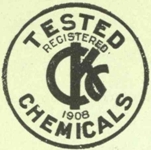
Certainty in making negatives and prints depends as much on the quality of your chemicals as on any other one thing. All Kodak chemicals are tested both photographically and for purity before the C. K. C. tested seal is allowed to go upon them. That seal is your protection.
| Kodak Chemical Outfit | $0.30 | |
| Eastman Special Developer Powders, per dozen | .50 | |
| Ditto, per ½ dozen | .25 | |
| Eastman Special Developer Powders, per pkg. 5, in sealed glass tubes | .25 | |
| Eastman Hydrochinon Developer Powders, per dozen | .50 | |
| Ditto, per ½ dozen | .25 | |
| Eastman's Pyro Developer Powders, per dozen | .50 | |
| Ditto, per ½ dozen | .25 | |
| Ditto, per package 5 powders, in sealed glass tubes | .25 | |
| Elon, per 1-ounce | .50 | |
| Roylon, per 1-ounce bottle | .50 | |
| Hydrochinon, per 1-ounce bottle | .15 | |
| Eastman's Permanent Crystal Pyro, per 1-ounce bottle | .25 | |
| Velox Re-Developer Tubes, package of 12 tubes | .60 | |
| Hypo Sulphite of Soda, granular, per pound | .08 | |
| Alum, powdered, per pound | .10 | |
| Kodak Acid Fixing Powder, per pound package | .25 | |
| Ditto, per ½-pound package | .15 | |
| Ditto, per ¼-pound package | .10 | |
| Eastman Intensifier, glass tube, per tube | .15 | |
| Eastman Reducer, per box of 5 tubes | .25 | |
| Potassium Bromide, per ounce | .12 | |
| Kodak Tested Carbonate of Soda (desiccated), per 1-pound bottle | .20 | |
| Kodak Tested Sulphite of Soda (desiccated), per 1-pound bottle | .30 |
For Velox preparations see page 53. For Solio preparations, see page 55. For Tank Developer Chemicals, see page 43.
Kodak Sundries
| Eastman Photo Paste, 3-ounce tube | $0.15 | |
| Ditto, 5-ounce tube | .25 | |
| Eastman Thermometer | .50 | |
| Thermometer Stirring Rod | .60 | |
| Hard Rubber Stirring Rod | .20 | |
| Eastman Film Clips, 3½-inch, per pair (nickeled) | .30 | |
| Ditto, 5-inch | .35 | |
| Kodak Film Clips, 5-inch (wood), per pair | .15 | |
| Focusing Cloth, per yard | .50 | |
| Moulded Graduate, 4-ounce | .10 | |
| Ditto, 8-ounce | .15 | |
| Ditto, 16-ounce | .20 | |
| Ferrotype Plate, 10 × 14, light | .20 | |
| Ditto, 10 × 14, heavy | .25 | |
| Ditto, 18 × 24, heavy | .75 | |
| Kodak Print Roller, 2 × 6-inch rubber roller, nickeled frame | .50 | |
| Flexo Print Roller, 4-inch rubber roller, black enameled frame | .15 | |
| Eastman's Special Squeegee, 6-inch | .30 | |
| Ditto, 8-inch | .35 |
| Size | Developing and Printing Per Roll |
Developing only |
Printing only, Each Exposure | |||
| Mounted | Unmounted | Per Roll | Mounted | Unmounted | ||
| 1½ × 2 | 12 ex. only | $0.90 | $0.84 | $0.25 | $0.06 | $0.05½ |
| 1⅝ × 2½ | 12 ex. | .95 | .89 | .40 | .06 | .05½ |
| 1⅝ × 2½ | 8 ex. | .65 | .60 | .30 | ||
| 1⅝ × 2½ | 6 ex. | .50 | .45 | .20 | ||
| 2¼ × 2¼ | 6 ex. only | .50 | .47 | .20 | .06 | .05½ |
| 2¼ × 3¼ | 12 ex. | 1.40 | 1.28 | .50 | .08 | .07 |
| 2¼ × 3¼ | 6 ex. | .70 | .64 | .25 | ||
| 2¼ × 4¼ | 12 ex. | 1.50 | 1.38 | .70 | .08 | .07 |
| 3½ × 3½ | 12 ex. | 1.50 | 1.38 | .70 | .08 | .07 |
| 3¼ × 4¼ | 12 ex. | 1.50 | 1.38 | .70 | .08 | .07 |
| 3¼ × 4¼ | 6 ex. | .79 | .69 | .35 | ||
| 3¼ × 5½ | 10 ex. | 1.50 | 1.40 | .80 | .10 | .09 |
| 3¼ × 5½ | 6 ex. | .90 | .84 | .50 | ||
| 4 × 5 | 12 ex. | 1.80 | 1.68 | 1.00 | .10 | .09 |
| 4 × 5 | 6 ex. | .90 | .84 | .50 | ||
| 4¼ × 6½ | 6 ex. only | 1.20 | 1.05 | .60 | .12½ | .10 |
| 5 × 7 | 6 ex. only | 1.20 | 1.05 | .60 | .12½ | .10 |
| 2¼ × 7 | 6 ex. only | 1.40 | 1.28 | .50 | .16 | .14 |
| 3½ × 12 | 4 ex. only | 1.40 | 1.28 | .75 | .20 | .17 |
Unmounted prints are furnished unless otherwise specified in order.
"Double Weight" prints will be billed at mounted rates.
No orders executed for less than $0.25.
Prints mounted with "Kodak Dry Mounting Tissue," no curling.
| Each | Per doz. | |||
| 4¼ × 6½, on card | $0.35 | $3.00 | ||
| 6½ × 8½, on card | .50 | 5.00 | ||
| 8 × 10, on card | .75 | |||
| Lantern Slides | .50 | 5.00 | ||
| 10 × 12, on card | 1.00 | |||
| 11 × 14, on card | 1.25 | |||
| 14 × 17, on card | 1.50 |
Larger sizes in proportion.
3¼ × 5½ Enlargements, from 1⅝ × 2½ negatives, each, unmounted $0.15; mounted $0.16.
No extra charge for Sepia Tones. Small extra charge for double or triple mounting.
Where the kind of paper is not specified, we use our own judgment.
A specimen photograph made with any Kodak (not larger than 4 × 5) will be sent to any address in Canada upon receipt of four cents in stamps; No. 4A Folding Kodak, eight cents; No. 4 Panoram Kodak, twenty cents.
Travelers can always obtain fresh supplies of films at any of the following addresses:
London Kodak, Limited, Kingsway, W.C.; 60 Cheapside, E.C.; 115 Oxford Street, W.; 171-173 Regent Street. W.; 40 Strand, W.C.; 59 Brompton Road, S. W.; 1 and 2 Gracechurch Street, E.C.
Liverpool Kodak, Limited, 96 Bold Street
Birmingham Kodak, Limited, 45 Corporation Street
Newcastle Kodak, Limited, 34 Grainger Street
Glasgow Kodak, Limited, 72-74 Buchanan Street
Dublin Kodak, Limited, 89 Grafton Street
Paris Kodak Société Anonyme Française, Avenue de l'Opéra 5; Place Vendôme 4 Boulevard Des Italiens 9
Lyons Kodak Société Anonyme Française, Rue de la Republic 26
Lausanne Kodak Société Anonyme, Avenue Du Tribunal Federal 13
Nice Kodak Société Anonyme Française, Avenue de la Gare 34
Madrid Kodak Sociedad Anonima; Puerta Del Sol 4
Berlin Kodak Gesellschaft, m.b.H., Leipzigerstrasse 115-116; Unter Den Linden 26 Tauentzienstrasse 14
Brussels Kodak, Limited, Rue de l'Ecuyer 36
Copenhagen Kodak Aktieselskab, Ostergade 1
Vienna Kodak Gesellschaft, m.b.H. 1 Kärntnerstrasse 16
St. Petersburg Kodak, Limited, Bolschaia Konnuschenaia 19
Moscow Kodak, Limited, Petrovka 15-16
Milan Kodak Società Anonima; Corso Vittorio Emanule 34
Rome Kodak Società Anonima; Corso Umberto 1, 399
Naples Kodak Società Anonima, Via Roma 288
Venice Kodak Società Anonima; Piazza S. Marco 52
Budapest Kodak Társaság K. f. 4 Vaci-utca 9
Alexandria Kodak (Egypt) Societé Anonyme, Rue Chérif Pacha 30
Cairo Kodak (Egypt) S. A. Opera Square
Cape Town Kodak (South Africa), Limited, 92-96 St. George's Street
Melbourne Kodak (Australasia), Limited, 284 Collins Street
Sydney Kodak (Australasia), Limited, 379 George Street
Brisbane Kodak (Australasia), Limited, 78 Queen Street
Adelaide Kodak (Australasia), Limited, 97 Rundle Street
Wellington Kodak (Australasia), Limited, 9 Mercer Street
Bombay Kodak, Limited, Cook's Building, Hornby Road
The prices in this catalogue are strictly net, except to regular dealers who carry our goods in stock. For the convenience of our customers we recommend that they make their purchases from a dealer in photographic goods, as by so doing they can save both time and transportation charges.
CANADIAN KODAK CO., LIMITED,
TORONTO, CANADA.
End of the Project Gutenberg EBook of Kodaks and Kodak Supplies, 1914, by
Canadian Kodak Company
*** END OF THIS PROJECT GUTENBERG EBOOK KODAKS AND KODAK SUPPLIES, 1914 ***
***** This file should be named 33183-h.htm or 33183-h.zip *****
This and all associated files of various formats will be found in:
http://www.gutenberg.org/3/3/1/8/33183/
Produced by V. L. Simpson and the Online Distributed
Proofreading Team at http://www.pgdp.net (This file was
produced from images generously made available by The
Internet Archive/Canadian Libraries.)
Updated editions will replace the previous one--the old editions
will be renamed.
Creating the works from public domain print editions means that no
one owns a United States copyright in these works, so the Foundation
(and you!) can copy and distribute it in the United States without
permission and without paying copyright royalties. Special rules,
set forth in the General Terms of Use part of this license, apply to
copying and distributing Project Gutenberg-tm electronic works to
protect the PROJECT GUTENBERG-tm concept and trademark. Project
Gutenberg is a registered trademark, and may not be used if you
charge for the eBooks, unless you receive specific permission. If you
do not charge anything for copies of this eBook, complying with the
rules is very easy. You may use this eBook for nearly any purpose
such as creation of derivative works, reports, performances and
research. They may be modified and printed and given away--you may do
practically ANYTHING with public domain eBooks. Redistribution is
subject to the trademark license, especially commercial
redistribution.
*** START: FULL LICENSE ***
THE FULL PROJECT GUTENBERG LICENSE
PLEASE READ THIS BEFORE YOU DISTRIBUTE OR USE THIS WORK
To protect the Project Gutenberg-tm mission of promoting the free
distribution of electronic works, by using or distributing this work
(or any other work associated in any way with the phrase "Project
Gutenberg"), you agree to comply with all the terms of the Full Project
Gutenberg-tm License (available with this file or online at
http://gutenberg.org/license).
Section 1. General Terms of Use and Redistributing Project Gutenberg-tm
electronic works
1.A. By reading or using any part of this Project Gutenberg-tm
electronic work, you indicate that you have read, understand, agree to
and accept all the terms of this license and intellectual property
(trademark/copyright) agreement. If you do not agree to abide by all
the terms of this agreement, you must cease using and return or destroy
all copies of Project Gutenberg-tm electronic works in your possession.
If you paid a fee for obtaining a copy of or access to a Project
Gutenberg-tm electronic work and you do not agree to be bound by the
terms of this agreement, you may obtain a refund from the person or
entity to whom you paid the fee as set forth in paragraph 1.E.8.
1.B. "Project Gutenberg" is a registered trademark. It may only be
used on or associated in any way with an electronic work by people who
agree to be bound by the terms of this agreement. There are a few
things that you can do with most Project Gutenberg-tm electronic works
even without complying with the full terms of this agreement. See
paragraph 1.C below. There are a lot of things you can do with Project
Gutenberg-tm electronic works if you follow the terms of this agreement
and help preserve free future access to Project Gutenberg-tm electronic
works. See paragraph 1.E below.
1.C. The Project Gutenberg Literary Archive Foundation ("the Foundation"
or PGLAF), owns a compilation copyright in the collection of Project
Gutenberg-tm electronic works. Nearly all the individual works in the
collection are in the public domain in the United States. If an
individual work is in the public domain in the United States and you are
located in the United States, we do not claim a right to prevent you from
copying, distributing, performing, displaying or creating derivative
works based on the work as long as all references to Project Gutenberg
are removed. Of course, we hope that you will support the Project
Gutenberg-tm mission of promoting free access to electronic works by
freely sharing Project Gutenberg-tm works in compliance with the terms of
this agreement for keeping the Project Gutenberg-tm name associated with
the work. You can easily comply with the terms of this agreement by
keeping this work in the same format with its attached full Project
Gutenberg-tm License when you share it without charge with others.
1.D. The copyright laws of the place where you are located also govern
what you can do with this work. Copyright laws in most countries are in
a constant state of change. If you are outside the United States, check
the laws of your country in addition to the terms of this agreement
before downloading, copying, displaying, performing, distributing or
creating derivative works based on this work or any other Project
Gutenberg-tm work. The Foundation makes no representations concerning
the copyright status of any work in any country outside the United
States.
1.E. Unless you have removed all references to Project Gutenberg:
1.E.1. The following sentence, with active links to, or other immediate
access to, the full Project Gutenberg-tm License must appear prominently
whenever any copy of a Project Gutenberg-tm work (any work on which the
phrase "Project Gutenberg" appears, or with which the phrase "Project
Gutenberg" is associated) is accessed, displayed, performed, viewed,
copied or distributed:
This eBook is for the use of anyone anywhere at no cost and with
almost no restrictions whatsoever. You may copy it, give it away or
re-use it under the terms of the Project Gutenberg License included
with this eBook or online at www.gutenberg.org
1.E.2. If an individual Project Gutenberg-tm electronic work is derived
from the public domain (does not contain a notice indicating that it is
posted with permission of the copyright holder), the work can be copied
and distributed to anyone in the United States without paying any fees
or charges. If you are redistributing or providing access to a work
with the phrase "Project Gutenberg" associated with or appearing on the
work, you must comply either with the requirements of paragraphs 1.E.1
through 1.E.7 or obtain permission for the use of the work and the
Project Gutenberg-tm trademark as set forth in paragraphs 1.E.8 or
1.E.9.
1.E.3. If an individual Project Gutenberg-tm electronic work is posted
with the permission of the copyright holder, your use and distribution
must comply with both paragraphs 1.E.1 through 1.E.7 and any additional
terms imposed by the copyright holder. Additional terms will be linked
to the Project Gutenberg-tm License for all works posted with the
permission of the copyright holder found at the beginning of this work.
1.E.4. Do not unlink or detach or remove the full Project Gutenberg-tm
License terms from this work, or any files containing a part of this
work or any other work associated with Project Gutenberg-tm.
1.E.5. Do not copy, display, perform, distribute or redistribute this
electronic work, or any part of this electronic work, without
prominently displaying the sentence set forth in paragraph 1.E.1 with
active links or immediate access to the full terms of the Project
Gutenberg-tm License.
1.E.6. You may convert to and distribute this work in any binary,
compressed, marked up, nonproprietary or proprietary form, including any
word processing or hypertext form. However, if you provide access to or
distribute copies of a Project Gutenberg-tm work in a format other than
"Plain Vanilla ASCII" or other format used in the official version
posted on the official Project Gutenberg-tm web site (www.gutenberg.org),
you must, at no additional cost, fee or expense to the user, provide a
copy, a means of exporting a copy, or a means of obtaining a copy upon
request, of the work in its original "Plain Vanilla ASCII" or other
form. Any alternate format must include the full Project Gutenberg-tm
License as specified in paragraph 1.E.1.
1.E.7. Do not charge a fee for access to, viewing, displaying,
performing, copying or distributing any Project Gutenberg-tm works
unless you comply with paragraph 1.E.8 or 1.E.9.
1.E.8. You may charge a reasonable fee for copies of or providing
access to or distributing Project Gutenberg-tm electronic works provided
that
- You pay a royalty fee of 20% of the gross profits you derive from
the use of Project Gutenberg-tm works calculated using the method
you already use to calculate your applicable taxes. The fee is
owed to the owner of the Project Gutenberg-tm trademark, but he
has agreed to donate royalties under this paragraph to the
Project Gutenberg Literary Archive Foundation. Royalty payments
must be paid within 60 days following each date on which you
prepare (or are legally required to prepare) your periodic tax
returns. Royalty payments should be clearly marked as such and
sent to the Project Gutenberg Literary Archive Foundation at the
address specified in Section 4, "Information about donations to
the Project Gutenberg Literary Archive Foundation."
- You provide a full refund of any money paid by a user who notifies
you in writing (or by e-mail) within 30 days of receipt that s/he
does not agree to the terms of the full Project Gutenberg-tm
License. You must require such a user to return or
destroy all copies of the works possessed in a physical medium
and discontinue all use of and all access to other copies of
Project Gutenberg-tm works.
- You provide, in accordance with paragraph 1.F.3, a full refund of any
money paid for a work or a replacement copy, if a defect in the
electronic work is discovered and reported to you within 90 days
of receipt of the work.
- You comply with all other terms of this agreement for free
distribution of Project Gutenberg-tm works.
1.E.9. If you wish to charge a fee or distribute a Project Gutenberg-tm
electronic work or group of works on different terms than are set
forth in this agreement, you must obtain permission in writing from
both the Project Gutenberg Literary Archive Foundation and Michael
Hart, the owner of the Project Gutenberg-tm trademark. Contact the
Foundation as set forth in Section 3 below.
1.F.
1.F.1. Project Gutenberg volunteers and employees expend considerable
effort to identify, do copyright research on, transcribe and proofread
public domain works in creating the Project Gutenberg-tm
collection. Despite these efforts, Project Gutenberg-tm electronic
works, and the medium on which they may be stored, may contain
"Defects," such as, but not limited to, incomplete, inaccurate or
corrupt data, transcription errors, a copyright or other intellectual
property infringement, a defective or damaged disk or other medium, a
computer virus, or computer codes that damage or cannot be read by
your equipment.
1.F.2. LIMITED WARRANTY, DISCLAIMER OF DAMAGES - Except for the "Right
of Replacement or Refund" described in paragraph 1.F.3, the Project
Gutenberg Literary Archive Foundation, the owner of the Project
Gutenberg-tm trademark, and any other party distributing a Project
Gutenberg-tm electronic work under this agreement, disclaim all
liability to you for damages, costs and expenses, including legal
fees. YOU AGREE THAT YOU HAVE NO REMEDIES FOR NEGLIGENCE, STRICT
LIABILITY, BREACH OF WARRANTY OR BREACH OF CONTRACT EXCEPT THOSE
PROVIDED IN PARAGRAPH F3. YOU AGREE THAT THE FOUNDATION, THE
TRADEMARK OWNER, AND ANY DISTRIBUTOR UNDER THIS AGREEMENT WILL NOT BE
LIABLE TO YOU FOR ACTUAL, DIRECT, INDIRECT, CONSEQUENTIAL, PUNITIVE OR
INCIDENTAL DAMAGES EVEN IF YOU GIVE NOTICE OF THE POSSIBILITY OF SUCH
DAMAGE.
1.F.3. LIMITED RIGHT OF REPLACEMENT OR REFUND - If you discover a
defect in this electronic work within 90 days of receiving it, you can
receive a refund of the money (if any) you paid for it by sending a
written explanation to the person you received the work from. If you
received the work on a physical medium, you must return the medium with
your written explanation. The person or entity that provided you with
the defective work may elect to provide a replacement copy in lieu of a
refund. If you received the work electronically, the person or entity
providing it to you may choose to give you a second opportunity to
receive the work electronically in lieu of a refund. If the second copy
is also defective, you may demand a refund in writing without further
opportunities to fix the problem.
1.F.4. Except for the limited right of replacement or refund set forth
in paragraph 1.F.3, this work is provided to you 'AS-IS' WITH NO OTHER
WARRANTIES OF ANY KIND, EXPRESS OR IMPLIED, INCLUDING BUT NOT LIMITED TO
WARRANTIES OF MERCHANTIBILITY OR FITNESS FOR ANY PURPOSE.
1.F.5. Some states do not allow disclaimers of certain implied
warranties or the exclusion or limitation of certain types of damages.
If any disclaimer or limitation set forth in this agreement violates the
law of the state applicable to this agreement, the agreement shall be
interpreted to make the maximum disclaimer or limitation permitted by
the applicable state law. The invalidity or unenforceability of any
provision of this agreement shall not void the remaining provisions.
1.F.6. INDEMNITY - You agree to indemnify and hold the Foundation, the
trademark owner, any agent or employee of the Foundation, anyone
providing copies of Project Gutenberg-tm electronic works in accordance
with this agreement, and any volunteers associated with the production,
promotion and distribution of Project Gutenberg-tm electronic works,
harmless from all liability, costs and expenses, including legal fees,
that arise directly or indirectly from any of the following which you do
or cause to occur: (a) distribution of this or any Project Gutenberg-tm
work, (b) alteration, modification, or additions or deletions to any
Project Gutenberg-tm work, and (c) any Defect you cause.
Section 2. Information about the Mission of Project Gutenberg-tm
Project Gutenberg-tm is synonymous with the free distribution of
electronic works in formats readable by the widest variety of computers
including obsolete, old, middle-aged and new computers. It exists
because of the efforts of hundreds of volunteers and donations from
people in all walks of life.
Volunteers and financial support to provide volunteers with the
assistance they need, are critical to reaching Project Gutenberg-tm's
goals and ensuring that the Project Gutenberg-tm collection will
remain freely available for generations to come. In 2001, the Project
Gutenberg Literary Archive Foundation was created to provide a secure
and permanent future for Project Gutenberg-tm and future generations.
To learn more about the Project Gutenberg Literary Archive Foundation
and how your efforts and donations can help, see Sections 3 and 4
and the Foundation web page at http://www.pglaf.org.
Section 3. Information about the Project Gutenberg Literary Archive
Foundation
The Project Gutenberg Literary Archive Foundation is a non profit
501(c)(3) educational corporation organized under the laws of the
state of Mississippi and granted tax exempt status by the Internal
Revenue Service. The Foundation's EIN or federal tax identification
number is 64-6221541. Its 501(c)(3) letter is posted at
http://pglaf.org/fundraising. Contributions to the Project Gutenberg
Literary Archive Foundation are tax deductible to the full extent
permitted by U.S. federal laws and your state's laws.
The Foundation's principal office is located at 4557 Melan Dr. S.
Fairbanks, AK, 99712., but its volunteers and employees are scattered
throughout numerous locations. Its business office is located at
809 North 1500 West, Salt Lake City, UT 84116, (801) 596-1887, email
business@pglaf.org. Email contact links and up to date contact
information can be found at the Foundation's web site and official
page at http://pglaf.org
For additional contact information:
Dr. Gregory B. Newby
Chief Executive and Director
gbnewby@pglaf.org
Section 4. Information about Donations to the Project Gutenberg
Literary Archive Foundation
Project Gutenberg-tm depends upon and cannot survive without wide
spread public support and donations to carry out its mission of
increasing the number of public domain and licensed works that can be
freely distributed in machine readable form accessible by the widest
array of equipment including outdated equipment. Many small donations
($1 to $5,000) are particularly important to maintaining tax exempt
status with the IRS.
The Foundation is committed to complying with the laws regulating
charities and charitable donations in all 50 states of the United
States. Compliance requirements are not uniform and it takes a
considerable effort, much paperwork and many fees to meet and keep up
with these requirements. We do not solicit donations in locations
where we have not received written confirmation of compliance. To
SEND DONATIONS or determine the status of compliance for any
particular state visit http://pglaf.org
While we cannot and do not solicit contributions from states where we
have not met the solicitation requirements, we know of no prohibition
against accepting unsolicited donations from donors in such states who
approach us with offers to donate.
International donations are gratefully accepted, but we cannot make
any statements concerning tax treatment of donations received from
outside the United States. U.S. laws alone swamp our small staff.
Please check the Project Gutenberg Web pages for current donation
methods and addresses. Donations are accepted in a number of other
ways including checks, online payments and credit card donations.
To donate, please visit: http://pglaf.org/donate
Section 5. General Information About Project Gutenberg-tm electronic
works.
Professor Michael S. Hart is the originator of the Project Gutenberg-tm
concept of a library of electronic works that could be freely shared
with anyone. For thirty years, he produced and distributed Project
Gutenberg-tm eBooks with only a loose network of volunteer support.
Project Gutenberg-tm eBooks are often created from several printed
editions, all of which are confirmed as Public Domain in the U.S.
unless a copyright notice is included. Thus, we do not necessarily
keep eBooks in compliance with any particular paper edition.
Most people start at our Web site which has the main PG search facility:
http://www.gutenberg.org
This Web site includes information about Project Gutenberg-tm,
including how to make donations to the Project Gutenberg Literary
Archive Foundation, how to help produce our new eBooks, and how to
subscribe to our email newsletter to hear about new eBooks.